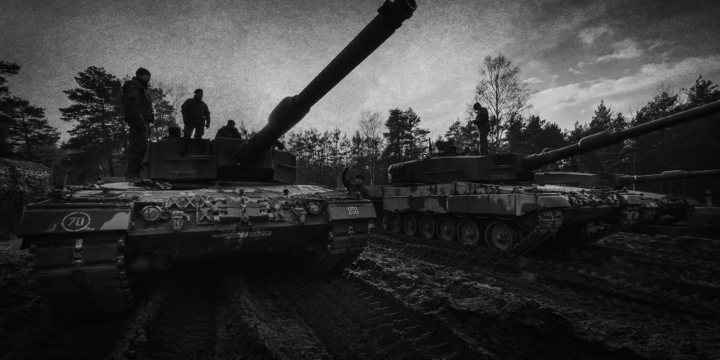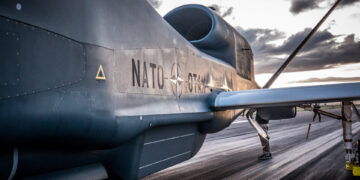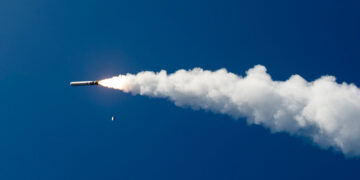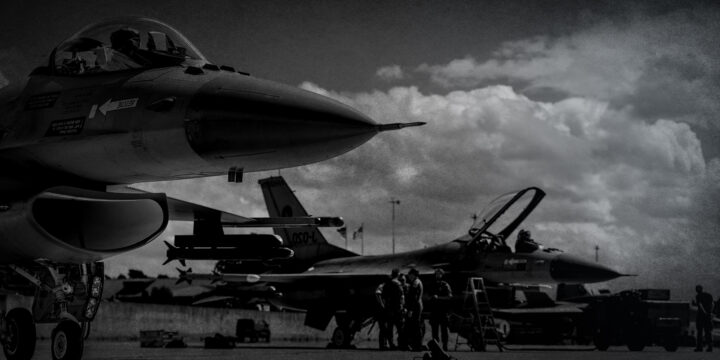November 6, 2024
A defensive approach to Ukraine military aid
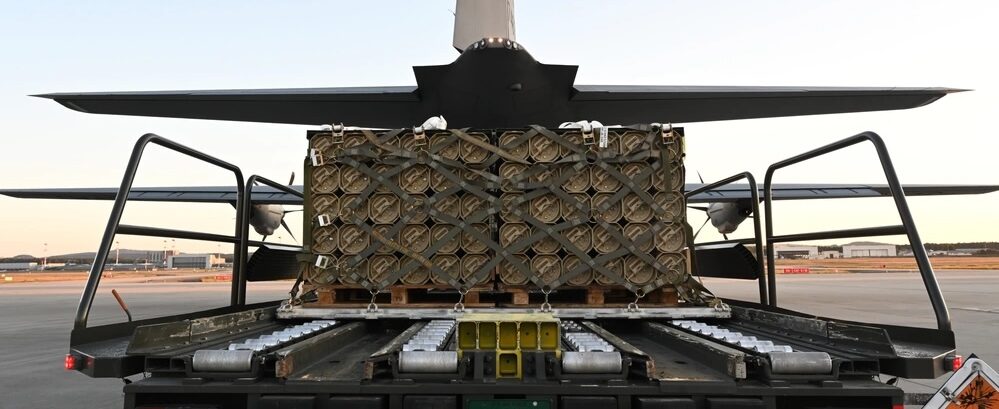
Key points
- The next administration is likely to continue U.S. military aid to Ukraine to some degree, yet thus far decisions about what aid to provide have been reactive and not connected to any strategy.
- The United States should use its military aid to push Ukraine to adopt a defensive strategy that will be more sustainable for the Ukrainians given manpower shortfalls and more responsible and fiscally feasible for the United States, while also reducing the risk of Russian escalation.
- This would be in line with America’s priorities in Ukraine, including preventing a Russian victory and preserving a sovereign Ukraine at lowest possible cost and without direct involvement in the war. This strategy would also put Ukraine in a good position for a settlement that trades some land for a ceasefire and supports Ukraine’s longer-term defense.
- A Ukraine aid framework centered on a defensive strategy would see the U.S. provide air defense, anti-tank mines, the material and equipment to build fortifications, short-range artillery and limited short-range missile variants, small uncrewed aerial systems, and some armored vehicles for transport. In many cases, however, quantities would be limited by the needs of U.S. forces or other U.S. partners.
- The U.S. would not provide most types of aircraft, long-range missiles, tanks, or other weapon systems that are primarily offensive in nature and could cross a redline for Vladimir Putin.
Since 2022, the United States has given Ukraine almost $60 billion in weapons. The Biden administration’s management of this aid has attracted criticism from the start. Many critics fault the United States for providing too little aid too slowly. They argue that Vladimir Putin’s threats are no more than empty saber-rattling, and that Kyiv should receive whatever it needs to drive Russia out of Ukraine.1Alexander Vindman, “What the U.S. Election Means for Ukraine,” Foreign Affairs, September 25, 2024, https://www.foreignaffairs.com/ukraine/what-us-election-means-ukraine. Others push for more restraint, warning that the potential for escalation makes the administration’s continually growing list of approved technologies and systems too risky.2George Beebe, “Not enough long range missiles to make a difference for Ukraine,” Responsible Statecraft, September 13, 2024, https://responsiblestatecraft.org/ukraine-long-range-missiles/; Stephen Biddle, “The False Promise of Ukraine’s Deep Strikes Into Russia,” Foreign Affairs, August 28, 2024, https://www.foreignaffairs.com/ukraine/false-promise-ukraines-deep-strikes-russia. Still others protest on the grounds of military effectiveness, pointing out that with insufficient manpower, no amount of equipment or caliber of advanced weapon is likely to give Ukraine what it needs to reclaim its lost territory.3Michael DiMino, “No Silver Bullet: Aid is Not a Shortcut to Victory for Ukraine,” Defense Priorities, June 21, 2024, https://www.defensepriorities.org/explainers/no-silver-bullet/; Emma Ashford, Joshua Shifrinson, and Stephen Wertheim, “What Does America Want in Ukraine?” Foreign Policy, May 9, 2024, https://foreignpolicy.com/2024/05/09/america-ukraine-forever-war-congress-aid/. Seeing little military benefit, these critics question the continuation of aid in any form.
President Joe Biden’s time in office is ending, but debates over how the United States should continue to support its beleaguered partner will endure. The next administration will likely need to continue providing Ukraine with some type of military support. Even once a settlement is reached, Ukraine may need help building a long-term security posture that can prevent a future Russian invasion. With majorities in Congress still supportive of continued military aid to Ukraine, opponents seem unlikely to derail another emergency assistance supplemental in 2025, though there are questions as to how much aid would be included and how long the aid would continue.
Decisions about what kinds of military aid to provide thus far have been reactive and not connected to any strategy. It has not always been clear how the weapons in question—in number and kind—will allow Ukraine to achieve its objectives. This has led to operational failures, wasted resources, and unnecessary risk of escalation. Some types of aid, like artillery, have contributed a lot to Ukraine’s successes, while other highly sought after hardware, like U.S. Abrams tanks and longer-range missiles, have tested Russian redlines and pulled scarce weapons systems away from higher U.S. priorities without producing the expected results.
Reducing military aid to Ukraine and pushing Kyiv to a settlement that would end the war would likely be the best course for long-term U.S. interests.4Joshua Shifrinson, “American Interests in the Ukraine War,” Defense Priorities, September 2023, https://www.defensepriorities.org/reports/american-interests-in-the-ukraine-war/. After all, Russia has suffered as a result of invading Ukraine. It has lost manpower and seen its military capability badly degraded—reminders of the perils of aggression. And with Kyiv outmatched in terms of personnel numbers and weapons stocks, the benefits of continued U.S. aid are limited and possibly not worth the risk of direct war between Russia and the United States, or the costs borne by the American taxpayer for each additional national security appropriation. But if the United States is going to continue to provide military aid to Kyiv, the next administration should define a clear set of criteria for deciding what capabilities (new and old) it might provide to Ukraine in the near and medium terms, and which capabilities will remain or be taken off the table permanently.
This paper offers such a framework, organized around three main criteria: military effectiveness, escalation risk, and military costs and tradeoffs. It starts by defining the remaining U.S. aims in Ukraine and the feasible outcomes that best support those aims. It then discusses the three screening criteria in relation to these desired outcomes. Finally, it proposes and applies a decision tree to guide policymakers in making choices about which military systems should be included in future aid packages. The framework does not address every capability Ukraine has or might receive, but it covers most major categories and offers guidelines that can be applied more broadly.
U.S. priorities in Ukraine
From the outset of the war, the United States had one main goal, to prevent Russian victory, while harboring a secondary aim of punishing Russia for its aggression. These aims have been largely achieved. Though Russia continues to make gains in the Donbas, it is unlikely that Moscow will be able to overrun Kyiv as it initially hoped in 2022. Russia’s military has been badly degraded, having lost many of its top officers and much of its newest and highest quality military hardware and munitions, and its economy has come under strain.5“Equipment Losses in Russia’s War on Ukraine Mount,” International Institute for Strategic Studies (IISS), February 12, 2024, https://www.iiss.org/online-analysis/military-balance/2024/02/equipment-losses-in-russias-war-on-ukraine-mount/.
However, Washington’s appetite for bearing the costs and risks necessary to achieve these two goals has always had its limits. For instance, the United States has not been willing to involve U.S. forces directly in the war and has sought to avoid triggering Russian escalation, including nuclear use. These undesired outcomes have thus far been avoided, though the risk of U.S. involvement and especially escalation remains.
For the United States, the best outcome would likely be a peace-for-land agreement that would give Russia some of the territory it now holds (but perhaps not all) in return for preserving an independent Ukraine along with some arrangement, short of a U.S. security guarantee, to support Ukraine’s long-term defense. This would prevent additional Russian gains, reduce the demand for future U.S. military assistance, and lower escalation risks that might pull the United States deeper into war. It is also the most feasible outcome. Manpower shortages mean that even with unlimited U.S. military assistance, Ukraine is unlikely to be able to push Russia out of its territory or reinstate its pre-2014 borders. A complete Ukrainian victory is also not clearly desirable from the U.S. perspective. The prospect of total military defeat could cause Putin to escalate through attacks on NATO countries or even the use of tactical nuclear weapons, an outcome the United States has worked to prevent.6Bryan Frederick, Mark Cozad, and Alexandra Stark, “Understanding the Risk of Escalation in the War in Ukraine,” RAND Corporation, 2023, https://www.rand.org/content/dam/rand/pubs/research_briefs/RBA2800/RBA2807-1/RAND_RBA2807-1.pdf; Emma Ashford and Kelly Grieco, “How Ukraine Can Win Through Defense,” Foreign Affairs, January 10, 2024, https://www.foreignaffairs.com/ukraine/how-ukraine-can-win-through-defense.
Any settlement to the current conflict, however, will include difficult decisions about how much land Ukraine should give up and how the country will deter future Russian land grabs—decisions that will be shaped by the military balance at the time of negotiations. The highest priority near-term U.S. goal, then, should be in putting Ukraine in the strongest possible position for these crucial negotiations, in a way that does not sacrifice U.S. military preparedness for other more important crises or push Russia away from real diplomacy.
The need for a defensive strategy
A defensive military strategy that consolidates current territory and prevents further losses is the path forward in Ukraine that is best aligned with U.S. vital interests. This is true for a few reasons.
First, a defensive strategy should be more achievable and sustainable for Ukraine than a strategy oriented toward offense because a defensive strategy has lower requirements. In most military contexts, the defender has the advantage. This is certainly true in Ukraine, where the country’s armed forces could build multiple defensive lines using cheap fortifications like bunkers, trenches, “dragon’s teeth,” and other obstacles; large quantities of inexpensive attritable drones; short-range artillery; anti-tank mines; and layered air defense at all ranges to hold off Russia’s advance.7Carl von Clausewitz, On War (London: Kegan Paul, Trench, Trubner & Co., 1918); Stephen Biddle, Military Power: Explaining Victory and Defeat in Modern Battle (Princeton: Princeton University Press, 2004). Offensive operations, in contrast, have high demands for expensive advanced systems, including long-range missiles, fighter jets, and sophisticated tanks, along with large numbers of personnel—requirements that are out of Ukraine’s reach. A common rule of thumb, for example, is that a successful offensive requires that that the attacker have a 3:1 advantage over the defender in terms of personnel.8John J. Mearsheimer, “Assessing the Conventional Balance: The 3:1 Rule and Its Critics,” International Security 13, no. 4 (1989): 54–89. Furthermore, accumulating defensive capabilities will be practical. Even after a settlement is reached, Ukraine will need these systems to credibly deter future Russian invasions.
As importantly, a defensive approach is less risky than one that continues to strive for offensive gains. Not only do offensive operations have a higher potential to trigger Russian escalation by crossing a redline, but they also run the risk of catastrophic failure, especially where personnel and weapons are constrained. If striving for offensive gains forces Ukraine to pull troops or weapons from defensive lines, those lines may collapse, resulting in larger losses and dooming any offensive success. This is effectively what has unfolded since Kyiv ordered the Kursk offensive. Although Ukraine achieved some initial gains inside of Russia, the effort drew essential forces and capabilities away from the eastern front, allowing Putin’s army to make rapid gains in the Donbas.9Christopher Miller, “Volodymyr Zelenskyy faces backlash over Russia’s breach of eastern defences,” Financial Times, August 30, 2024, https://www.ft.com/content/e63ce931-d3a1-4b4a-8540-e578d87873e5.
Because it relies on cheaper systems, many of which can be produced more quickly and in larger numbers, Washington should also find resourcing a defensive strategy in Ukraine more feasible both fiscally and in terms of military tradeoffs, for example with U.S. readiness and the needs of other priority partners. With the U.S. defense industrial base already under strain, and with demands coming not only from Ukraine but also U.S. forces themselves and other U.S. allies, Washington will need to be discerning in how it allocates scarce defense industrial base capacity. Many defensive weapons can be produced more quickly and cheaply than exquisite offensive ones, for example mines, some kinds of ammunition, small drones and loitering munitions, and some kinds of anti-ship missiles. This should make an approach to aiding Ukraine that stresses defensive capabilities more sustainable and manageable for the United States, given its other commitments.
Given the greater feasibility and lower cost and risk of a defensive approach—and the fact that further offensive operations are unlikely to succeed—future deliveries of military aid should be assessed rigorously on their ability to build up Ukraine’s defensive arsenal while keeping the United States out of the war and minimizing costs to other U.S. priorities. This suggests three screening criteria for future aid deliveries. Specifically, future aid should be evaluated based on:
- Military effectiveness, in particular the ability of a given system to augment Ukraine’s defensive capabilities in the near and medium terms;
- Escalation risks, with an eye towards minimizing the chance for unintended Russian retaliation that could pull the United States into war;
- The costs and tradeoffs of any aid provided to Ukraine, including to other partners and allies that might need similar systems and the sufficiency of U.S. stockpiles.
The next section discusses these three criteria in more detail.
Evaluating future military assistance
The three criteria used in the framework presented here are complementary and can be applied sequentially. If a given weapon system does not substantially advance Ukraine’s defensive military position, then there is no reason to incur even a small escalation risk or to accept any burden on U.S. stockpiles. Similarly, if a system could aid Ukraine’s defensive strategy but has a high escalation risk, then it should be ruled out regardless of its availability.
Military effectiveness
The most important consideration for any future military system provided to Ukraine should be its ability to support a defensive strategy that would let Kyiv consolidate the territory it now holds and build layered fortifications to prevent future Russian attacks. While this sounds straightforward, the debate about what counts as a “defensive” military capability and what is “offensive” is quite contentious. In part, this is because most capabilities can be used in both offensive and defensive capacities. Kier Lieber, for instance, has argued that it is not possible to separate military technologies into those that favor the offense and those that favor the defense because they overlap too extensively. The capabilities an attacker needs to break through enemy lines and hold enemy territory, he suggests, are the same as the ones that a defender needs to fortify and reinforce defensive positions and neutralize adversary advances.10Keir A. Lieber, “Grasping the Technological Peace: The Offense-Defense Balance and International Security,” International Security 25, no. 1 (2000): 71–104; Lieber, “Mission Impossible: Measuring the Offense-Defense Balance with Military Net Assessment,” Security Studies 20 (2001): 451–459.
This is a fair critique, but it also a bit of a dodge. Certainly, many military systems have dual purpose and can support offensive and defensive operations, but in any geographic context and during a specific conflict, it should be possible to define some general guidelines for identifying capabilities more likely to support the offense than the defense. Generally, offensive capabilities may be defined as those that enable an attacker to seize territory, including those technologies that enable force mobility, operational speed, and projection of military power over long distances. In contrast, defensive capabilities are those that offer protective firepower and that create barriers or obstacles to advancing enemy forces, allowing the defender to hold and consolidate existing territory only.11Jack S. Levy, “The Offensive/Defensive Balance of Military Technology: A Theoretical and Historical Analysis,” International Studies Quarterly 28, no. 2 (1984): 219–238.
Using these criteria, it is easier to categorize certain systems as primarily offensive or defensive. Naval and anti-tank mines, fortifications like concrete barriers, heavy and short-range artillery, and air defenses of almost any kind can be considered primarily defensive capabilities. These systems are useful for protecting forces and territory but would be less advantageous if the goal were to reclaim adversary-held territory or roll back adversary forces. Anti-ship missiles will similarly be most useful on the defensive. Capabilities like radars and advanced sensing technologies are also relevant as they can improve domain awareness in ways that support air and coastal defense. In no-first-use nuclear environments, nuclear weapons are also a defensive capability.12Levy, “Offensive/Defensive Balance.” In contrast, systems that tend to favor the offensive will include tanks and other mechanized vehicles, mobile and long-range artillery, most long-range missiles, and high-speed aircraft like fighter jets and long-range drones—in other words, capabilities that allow military power to reach farther and move faster.
Context—like geography and how a system is used—will matter, of course. Tanks may be generally offensive in nature, but in maritime environments like Asia, they will be much less useful for offensive operations than on continental battlefields and might even have some defensive use, as a bulwark against amphibious attackers.13David Blagden, “When Does Competition Become Conflict? Technology, Geography, and the Offense-Defense Balance,” Journal of Global Security Studies 6, no. 4 (2021) https://academic.oup.com/jogss/article/6/4/ogab007/6238548. Long-range missiles provide the greatest advantage for attackers, weakening enemy defenses to ease the path for the offensive surge, but a defender might use them to eliminate adversary missile launchers as part of a counterstrike campaign to prevent further enemy attacks.
Whether a system is useful for offense or defense will also depend on the package of technology that accompanies it. Mobile artillery may be applied as part of an offensive surge or part of a defensive stand. When combined with air defense, fortifications, anti-tank mines, and short-range munitions, mobile artillery may be most useful on the defensive.14Blagden, “When Does Competition Become Conflict?” When paired with tanks, fighter jets, longer-range munitions, and other mechanized vehicles, mobile artillery may be more offensive.
There will always be a gray area between capabilities intended for offense and defense, but for the purpose of this framework, all that is necessary is to determine whether, in the context of the war in Ukraine, a given system is more likely to help Ukraine hold or seize territory. Tanks were intended to serve as offensive weapons, to punch through adversary lines, though they have largely failed at this.15David Brennan, “America’s Abrams Tanks Are Failing the Ukraine Test,” Newsweek, April 26, 2024, https://www.newsweek.com/american-abrams-tanks-failing-ukraine-test-russia-drones-1894503. Ukraine has largely used short-range artillery defensively since its initial gains in 2022. Long-range missiles, such as Army Tactical Missile System (ATACMS), could have dual uses, the first being to eliminate Russian firing positions as part of a defensive struggle, and the second being to ease offensive operations by wearing down the adversary’s war-making capabilities. The latter mission requires a large stockpile of longer-range missiles, however, which Ukraine does not currently have.
Assessing whether a capability is primarily defensive or primarily offensive in orientation is only one part of gauging its military effectiveness, however. Within those capabilities that have some defensive utility, the level of benefit Ukraine derives from a given system will vary. Some, like air defense and fortifications, may offer large benefits to defensive operations.16Ashford and Grieco, “How Ukraine Can Win.” Others may contribute in minor ways. For example, the offensive and defensive value of tanks in Ukraine has been undermined by their large size which has made them easy targets. In contrast, small drones have been very valuable defensively, but any offensive impact has been limited by their shorter range and more limited firepower.
Like classifying systems as offensive or defensive, any assessment of military value will be speculative and inexact. To make decisions about future military assistance to Ukraine, however, all that is required is a general sense of the magnitude of benefits that can be compared to escalation risks and tradeoffs. Low benefit systems might be taken off the table immediately, while those with moderate benefits might remain in discussion.
Finally, policymakers should not ignore factors like international and U.S. law when weighing military effectiveness. Already the United States has given Ukraine older ATACMS that use cluster munitions. This is legal because the United States is not a party to the ban on these weapons, but many have questioned whether it is advisable given humanitarian costs.17Karen DeYoung and John Hudson, “U.S. Will Send Ukraine Long-Range Missiles, after Delay,” Washington Post, September 22, 2023, https://www.washingtonpost.com/national-security/2023/09/22/atacms-ukraine-cluster-munitions/. Anti-personnel mines are another example of a technology the U.S. allows in some contexts but that many countries prohibit under international treaty.18Jeff Abramson, “Ukraine Landmine Use Under Scrutiny,” Arms Control Association, March 2023, https://www.armscontrol.org/act/2023-03/news/ukraine-landmine-use-under-scrutiny. The Pentagon has also recommended providing Ukraine with munitions that contain white phosphorous, which may be useful defensively, for disguising operations, but can produce serious chemical burns.19Courtney Kube, “Pentagon Has Recommended Giving White Phosphorus Shells to Ukraine, but White House Keeps Saying No,” NBC News, September 25, 2024, https://www.nbcnews.com/investigations/pentagon-wants-white-phosphorus-shells-ukraine-white-house-says-no-rcna172504. The United States should carefully consider the implications of transferring such systems. It will be much harder for the United States to condemn Russia’s use of white phosphorous if they provide this weapon to Ukraine, for example.
Escalation risks
The second criterion policymakers should consider when assessing military aid packages to Ukraine is the risk of escalation. Critics have argued that the United States has been too worried about escalation. Citing the lack of Russian nuclear use or attacks on NATO soil, these skeptics assert that Putin’s threats are a bluff. Ukrainian President Volodymyr Zelensky himself has called U.S. redlines “naïve” and “illusory.”20Constant Meheut, “Zelensky Says Push Into Russia Shows the West’s Red Lines Are ‘Naïve,’” New York Times, August 20, 2024, https://www.nytimes.com/2024/08/20/world/europe/ukraine-russia-war-incursion-zelensky.html; Alexander Vindman, “Stop Tiptoeing Around Russia,” Foreign Affairs, August 8, 2022, https://www.foreignaffairs.com/united-states/stop-tiptoeing-around-russia.
These critiques suffer from two flaws. First, there is little evidence that because Putin has not employed nuclear weapons or attacked a NATO member yet, he might not do so if he considers the threat existential. In fact, U.S. intelligence sources in September 2022 assessed the risk of Russian nuclear use to be close to 50 percent. This suggests dismissing Putin’s warnings as mere saber-rattling is ill-advised.21“US scrambled to urge Putin not to use nuclear weapons in Ukraine, Woodward book says,” Associated Press, October 8, 2024, https://apnews.com/article/russia-ukraine-war-putin-biden-nuclear-weapons-90cb3bb3499a5e211095b3f93173a575. Second, the focus on nuclear use and attacks on NATO territory ignores other ways that Putin has already escalated, including the use of sabotage in Western cities and support to Iran and the Houthis as the Middle East conflict has spiraled.22Benoit Faucon and Thomas Grove, “Russia Provided Targeting Data for Houthi Assault on Global Shipping,” Wall Street Journal, October 24, 2024, https://www.wsj.com/world/russia-provided-targeting-data-for-houthi-assault-on-global-shipping-eabc2c2b. When assessing the risk of escalation, in other words, analysts should consider not only steps up the escalation ladder, but also horizontal moves against U.S. and/or European interests outside of Ukraine.
The risk of escalation will be intimately related to whether the system is offensive or defensive in nature but the two are not the same. An adversary may choose to escalate in a conflict for one of several reasons. First, capabilities that generally have an offensive intent, that are aimed at allowing an ally or partner (or U.S. forces) to seize adversary terrain or adversary-held terrain, may be escalatory because they signal an effort to roll back adversary forces and to change the balance of power on the battlefield. As described at length above, the capabilities that fall into this category will be somewhat context dependent. In Ukraine, they are most likely to involve systems and weapons with high mobility and power projection potential, including especially light mechanized vehicles, advanced tanks, long-range weapons and munitions, glide bombs, and fighter aircraft.
However, even defensive capabilities can prove destabilizing if they implicate or weaken an adversary’s ability to deter. For instance, although air defense is largely defensive, because it can neutralize an adversary’s missile arsenal, it could prove destabilizing in the context of an extended conflict, driving the adversary to move up the escalation ladder to maintain deterrence.23Levy, “Offensive/Defensive Balance”; Blagden, “When Does Competition Become Conflict?” Longer-range missiles used to strike adversary missile launchers or radars may be defensive, intended to slow advancing forces, but they can still be escalatory, especially if they strike inside the adversary’s borders. Still, the escalation risk of defensive capabilities is likely to be substantially less than that for offensive ones. This seems especially true of cases like Ukraine where the military balance is so lopsided.
Another reason an adversary might choose to escalate is it perceives a severe or existential threat to regime security. This might originate in capabilities that can execute regime decapitation, take out an enemy’s nuclear stockpile, or disable an adversary’s command and control.24James M. Acton, “Escalation through Entanglement: How the Vulnerability of Command-and-Control Systems Raises the Risks of an Inadvertent Nuclear War,” International Security 43, no. 1 (2018): 56–99; Tong Zhao, “Conventional Long-Range Strike Weapons of US Allies and China’s Concerns of Strategic Instability,” Nonproliferation Review 27 (2020): 109–122. In the Ukraine context, long-range strikes capable of hitting Moscow, nuclear facilities, or early warning radars will be among the most escalatory.
Finally, anything that deepens integration between a patron and a partner could be perceived as threatening to an adversary, especially if that integration implies a material change in the capabilities of the partner. This could include integration that gives the partner access to more advanced intelligence and targeting information, more advanced technologies, or new industrial capacity or capital for investment.
In Asia, for example, China has reacted particularly negatively to the AUKUS agreement, which has the United States, United Kingdom, and Australia sharing nuclear technology and jointly producing and operating advanced submarines. Beijing’s response has focused as much on the integration and coordination the arrangement implies between the allied countries as on the capabilities being shared themselves.25“China says AUKUS on ‘dangerous path’ with nuclear subs deal,” Associated Press, March 14, 2023, https://apnews.com/article/china-aukus-nuclear-submarines-f6ecf854646e2dbddd6ebeaa2f2e971d. Different types of integration might not be equally escalatory, however. Access to new technology, intelligence, or targeting information may be substantially more concerning to an adversary than integrated training or military aid.
Much will depend on context. For Putin, any integration between Ukraine and NATO may be troubling given his fears about losing Kyiv to its Western partners. Anything that suggests integration of command and control, targeting, or early warning capabilities such that NATO countries end up playing a more direct role in the conflict may be especially escalatory.26Frederick, Cozad, and Stark, “Understanding the Risk of Escalation.” Similarly, the escalatory potential of integrated training may depend on the location of that training. Training in Ukraine, for instance, would be much more provocative than training in the West (which is already occurring). Finally, the technologies involved will matter. Transfer of basic technologies may not be a concern, but sharing of advanced U.S. capabilities that are restricted to close allies and partners might be escalatory.
Beyond these specific triggers, the quantity and speed of any new transfers may also be relevant to adversary calculations.27Stephen Watts et al., Deterrence and Escalation in Competition with Russia: The Role of Ground Forces in Preventing Hostile Measures below Armed Conflict in Europe (RAND Corporation, 2022), https://www.rand.org/pubs/research_reports/RRA720-1.html. If the number of systems transferred is relatively low, even a provocative capability may have little effect on a conflict’s stability. In larger quantities, however, those same capabilities may be enough to upset a prevailing balance. In the context of Ukraine, then, just because a small number of ATACMS and F-16s have failed to drive Putin up the escalatory ladder does not mean that increasing the provision of these systems will similarly evade a redline.28Frederick, Cozad, and Stark, “Understanding the Risk of Escalation.”
As in the case of military effectiveness, any assessment of escalation risks will be in degrees. Any weapons transfer during a conflict likely bears some kind of risk, but some capabilities may be more escalatory than others. For policymakers, the challenge will be to approximate the level of risk incurred relative to the military effectiveness gains and alternative systems that could be provided. Weighing this risk against the military effectiveness or expected gain should offer insight into whether a specific transfer works in favor or against U.S. priorities in Ukraine.
Costs and tradeoffs
The final factor that policymakers should consider when making choices about future military aid to Ukraine is the costs and tradeoffs associated with giving a specific system or weapon to Kyiv rather than using it to arm U.S. forces or another U.S. ally or partner.
Aid to Ukraine has come through two main channels. Some assistance has been sent using Presidential Drawdown Authority (PDA), which allows the president to pull directly from U.S. stocks. The remainder has come in contracts for new systems and equipment as part of the Ukraine Security Assistance Initiative and Foreign Military Financing.29“Report to Congress on Defense Production for Ukraine,” Congressional Research Service Report, September 16, 2024, https://s3.documentcloud.org/documents/25163101/defense-production-for-ukraine-background-and-issues-for-congress-sept-16-2024.pdf.
Aid provided through PDA is limited by the depth of U.S. stockpiles and how quickly donated supplies can be replaced. In some cases, the United States has lots of excess capacity and can afford to continue to give generously to Ukraine’s Armed Forces. In others, U.S. stocks are already under pressure and giving more to Ukraine would put U.S. military readiness at risk.30Congressional Research Service, “Defense Production for Ukraine.” For example, the United States is already running short on air defense systems and missiles, so despite Ukraine’s need for these systems, transfers of Patriot and Avenger air defense systems and their missiles have slowed over time as U.S. readiness becomes a more substantial consideration.31Christine Wormuth, “Ground Forces and Great Powers,” Stimson Center, September 19, 2024, https://www.stimson.org/2024/transcript-ground-forces-and-great-powers-a-conversation-with-u-s-army-secretary-christine-wormuth/. Decision-makers may sometimes be willing to take some risk by temporarily depleting U.S. arsenals, but when replacement timelines are long, as they are for air defense and long-range strike missiles, they should consider aid decisions carefully.
Similarly, systems and weapons transferred to Ukraine will not be available for other allies and partners who may have greater needs. Not many countries are eligible for drawdowns from U.S. stocks (Taiwan is one), with most allies and partners getting arms through the Foreign Military Sales (FMS) process, which allows them to purchase new systems from U.S. contractors. Because Ukraine is also receiving new production through the Ukraine Security Assistance Initiative, orders bound for Kyiv can slow down delivery of the same systems to these allies and partners.32Jennifer Kavanagh and Jordan Cohen, “The Real Reasons for Taiwan’s Arms Backlog – and How to Help Fill It,” War on the Rocks, January 13, 2023, https://warontherocks.com/2023/01/the-real-reasons-for-taiwans-arms-backlog-and-how-to-help-fill-it/. When the Biden administration decided to prioritize delivery of many types of air defense missiles to Ukraine, it meant that other allies and partners were left waiting.33Brian Everstine, “U.S. Prioritizing Patriot, NASAMS Interceptors for Ukraine,” Aviation Week, June 20, 2024, https://aviationweek.com/defense/missile-defense-weapons/us-prioritizing-patriot-nasams-interceptors-ukraine. The same may be true of other systems, including especially mobile artillery like the High Mobility Artillery Rocket System (HIMARS) and anti-ship missiles. In some cases and for some capabilities, arming Ukraine may take precedence. But in others, other partners may have a more immediate need, or at least a need that is as significant, suggesting the need for a more staggered approach to system delivery.
Of all U.S. arms clients, Taiwan has been perhaps most affected by the large quantities of aid being sent to Ukraine, and given the tradeoffs between the two, it deserves special attention here. While the two sets of needs are not entirely overlapping, many of the systems that Ukraine has needed most are also needed by Taiwan, including air defense at all ranges, anti-ship missiles, mobile artillery, and anti-tank mines. With U.S. stocks already drawn down, there is now less slack capacity to help Taiwan through the Presidential Drawdown authority that would get weapons to the island fastest.34Kavanagh and Cohen, “The Real Reasons for Taiwan’s Arms Backlog.” At the same time, most aid to Ukraine and Taiwan going forward will likely come through new production, where the two countries will continue to compete. As a result, Taiwan is likely to be affected by long delivery timelines, which are driven in part by the large volume of new orders intended for Ukraine, for the foreseeable future.35Kavanagh and Cohen, “The Real Reasons for Taiwan’s Arms Backlog.”
A final tradeoff worth noting is between additional military spending and investment on other priorities—domestic or international. Military aid to Ukraine that comes through new production has to this point been paid for by U.S. emergency appropriations totaling about $175 billion since 2022.36“Funding,” Ukraine Oversight, Special Inspector General for Operation Atlantic Resolve, Promoting Whole of Government Oversight of the U.S. Ukraine Response, https://www.ukraineoversight.gov/Funding. Ukraine’s backers argue that much of this funding—paid for by taxpayer dollars—serves as an investment in the U.S. defense industrial base, which creates jobs and manufacturing capabilities in the United States.37Mark Cancian and Chris Park, “What Is in the Ukraine Aid Package, and What Does it Mean for the Future of the War?” Center for Strategic and International Studies, May 1, 2024, https://www.csis.org/analysis/what-ukraine-aid-package-and-what-does-it-mean-future-war. However, it is worth asking whether this is the optimal use for this funding. For example, this same money could be invested in education or State Department diplomacy or to pay down the national debt.
Decisionmakers should attend to these opportunity costs when making decisions about future aid to Ukraine. However, this recommendation comes with a caveat. An opportunity cost assessment assumes that if money allocated to Ukraine were not spent on Ukraine, it would be allocated to something else. The reality is that the alternative will always be unknown. Money not spent on Ukraine might be invested domestically but it might not be spent at all. This ambiguity makes it hard to account for opportunity costs in the framework presented here, though decisionmakers should still keep it in mind when allocating resources.
Decision framework
These three criteria can be cohered into a decision framework that policymakers can use to make choices about what types of aid Washington should consider sending to Ukraine and what should be kept off the table.
Decision framework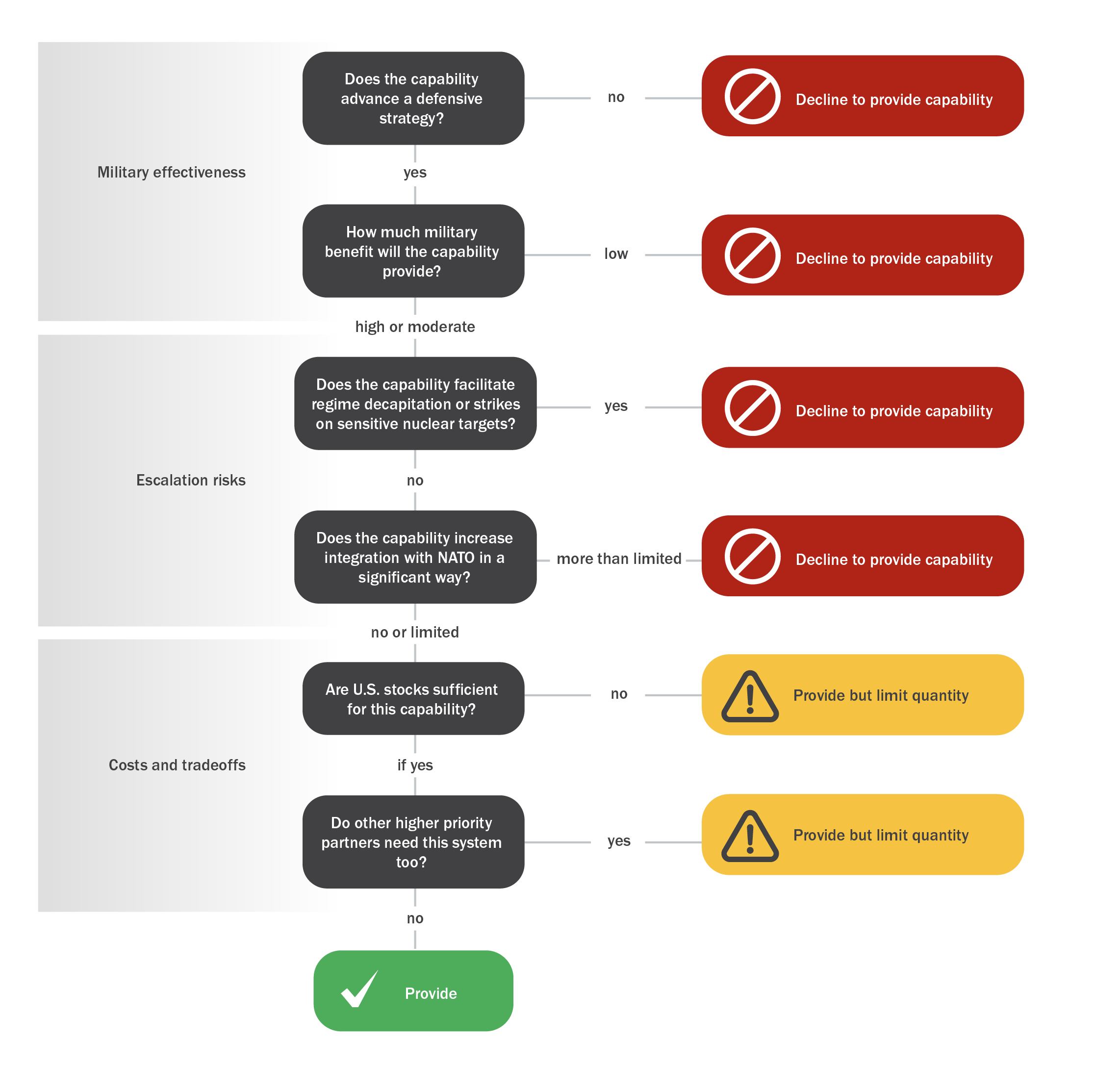
The framework offers a guide, but it is flexible, with room for discretion based on policymaker priorities and context. But even with that flexibility, it offers significant advantages over an ad hoc process that is not tied to a clear military strategy or that is driven by political pressure rather than assessments of military effectiveness and relevant costs and tradeoffs. The next section applies this framework to a range of different capabilities, including some Ukraine already has and wants more of and some it does not have but might ask for in the future.
Shaping future aid to Ukraine
The framework aims to maximize the defensive military value Ukraine receives from U.S. aid while minimizing the risk of escalation and the costs and tradeoffs to other U.S. security priorities. In general, the criteria in this framework warn against providing Ukraine with any new military system or advanced munition it does not already have, rule out expanded permissions for longer range systems, and suggest the need for careful attention to competing U.S. and allied needs for many systems Kyiv has already received in large numbers. They also suggest the need to claw back some U.S. commitments that are unlikely to advance a defensive strategy or that come with costs and risks that are too high. What would be left, then, is a narrow portfolio of military capabilities aimed at helping Ukraine consolidate and hold its remaining territory with strong defensive lines capable of stemming Russian advances.
Aircraft and unmanned aerial systems (UAS)
The United States has provided limited aircraft to Ukraine outside of unmanned aerial systems (UAS)—excepting a few helicopters—but it has approved the transfer of F-16s from European allies and facilitated the training of Ukrainian pilots to operate these aircraft. The tranche of aid provided to Ukraine in September 2024 included additional training slots for Ukrainian pilots, for instance. The framework here, however, would recommend against sending Ukraine any fighter jets, including additional F-16s as well as F-15s, F-18s, F-22s, or F-35s.
Fighter aircraft are primarily used for offensive operations and have a limited defensive purpose. F-16s could be used for air defense, to shoot down enemy aircraft or missiles, but this would be a very inefficient way for Ukraine to defend its skies, especially given the small numbers of jets it will have for the foreseeable future and few pilots who are prepared to complete even a condensed training course.38Sebastien Roblin, “Sending F-16s to Ukraine Is the Right Choice, But It Will Be a Tough Fight,” Newsweek, May 24, 2023, https://www.newsweek.com/sending-f-16s-ukraine-right-choice-it-will-tough-fight-opinion-1802461. Ukraine received its first fighter jets only in late July 2024, and already their limitations are clear. Ukraine lost one of its top fighter pilots and an F-16 aircraft that August due to factors including pilot error.39Reuben Johnson, “Ukraine’s Lost F-16: Debris and a Deadly Mission,” Breaking Defense, September 20, 2024, https://breakingdefense.com/2024/09/debris-and-a-deadly-mission-the-vital-context-around-ukraines-lost-f-16/. Ukraine also does not have the means to maintain the aircraft. As a result, they will have lengthy “out of service” periods while they are repaired elsewhere. When they are in service, they will be easy targets for Russian bombs while on the ground.40“Ukraine Now Has F-16s; Here’s What to Know about the Possible Impact,” VOA, August 4, 2024, https://www.voanews.com/a/ukraine-now-has-f-16s-here-s-what-to-know-about-the-possible-impact/7727046.html.
The decision to allow NATO allies to transfer F-16s to Ukraine has so far not sparked escalation, but this may reflect Putin’s calculation that their contribution will be limited for the near and medium terms. As Ukraine’s fleet and/or the number of trained pilots increases, Putin’s assessment could change, especially since the use of F-16s will drive greater integration between NATO allies and Ukraine, specifically around navigation, targeting, and support functions like maintenance. Similarly, if the United States decides to arm Ukraine with more advanced air-to-air and air-to-ground missiles (discussed in the next section), this also could drive escalation.
The United States likely has the veto power to indefinitely postpone additional F-16 transfers and pause pilot training, and it should. Fighter jets are an expensive distraction to a defensive strategy.
Airborne early warning and control (AEWC) aircraft are less offensive in nature than fighter jets, their main purpose being to detect adversary aircraft, ships, and missiles at long distances. They have a more substantial defensive role and could be useful to Ukraine in protecting its cities and skies from Russian attack. Ukraine does not yet have many of these jets, though Sweden has agreed to provide one.
While these aircraft would support a defensive strategy, their escalation risks would be high. Although they would not enable long-range strikes inside Russia, they would allow for deeper intelligence and sensing integration with NATO.41Parth Satam, “Ukraine to Get Sweden’s AWACS in First Airborne Radar Donation,” Aviationist, May 29, 2024, https://theaviationist.com/2024/05/29/ukraine-to-get-swedish-awacs/; “AWACS: NATO’s ‘Eyes in the Sky,’” NATO, November 14, 2023, https://www.nato.int/cps/en/natohq/topics_48904.htm. In fact, they would likely rely on access to NATO satellite and surveillance networks. This deeper integration would increase U.S. involvement in Ukrainian daily operations and so could elevate the risk of Russian escalation, especially horizontally, to include Russian activities in Europe or other theaters. Furthermore, it is likely that ground-based sensors and radars could give Ukraine some early warning capabilities with less extensive integration and lower risks of escalation.
On the other hand, small uncrewed aerial systems (UAS or aerial drones) and loitering munitions are capabilities that have high defensive values and lower escalation risks. Small UAS, for instance, can be useful in contesting Russian air control and defending Ukraine’s skies. Drones and loitering munitions have also proven effective in Ukraine at halting adversary ground advances and so could be useful in protecting Ukraine’s defensive perimeter or as part of a set of layered defensive lines.42Stacie L. Pettyjohn, “Drones Are Transforming the Battlefield in Ukraine but in an Evolutionary Fashion,” War on the Rocks, March 5, 2024, https://warontherocks.com/2024/03/drones-are-transforming-the-battlefield-in-ukraine-but-in-an-evolutionary-fashion/. To ensure military effectiveness, however, the United States and its allies will need a way to massively increase their production of small drones and develop more efficient means of updating their software to avoid jamming.43Jennifer Kavanagh, “Arming for the Air Littoral: The Defense Industrial Base and Future Air Warfare,” Aether: A Journal of Strategic Airpower & Spacepower 3, no. 3 (2024) https://www.airuniversity.af.edu/Portals/10/AEtherJournal/Journals/Volume-3_Number-3/Kavanagh.pdf.
One caveat on the transfer of small drones and loitering munitions, however, is that these systems are in high demand by U.S. and partner forces. Taiwan could use a large drone fleet and the U.S. military has similarly been focused on acquiring large numbers of small drones as part of its Replicator Initiative.44John Grady, “‘Hellscape’ Swarms Could Be a Cost-Effective Taiwan Defense, Says Report,” USNI News, July 2, 2024, https://news.usni.org/2024/07/01/hellscape-swarms-could-be-as-cost-effective-taiwan-defense-says-report. Samuel Paparo, the commander of Indo-Pacific Command, has said, for instance, that in the event of a conflict with China he hopes to turn the area around China’s coast into a “hellscape” of small UAS.45Carter Johnston, “Breaking Down the U.S. Nacy’s ‘Hellscape’ in Detail,” Naval News, June 16, 2024, https://www.navalnews.com/naval-news/2024/06/breaking-down-the-u-s-navys-hellscape-in-detail/. The United States should support Ukraine with small drones but must consider carefully how to allocate available DIB capacity devoted to these systems between U.S. forces, Taiwan, and Ukraine. Ukraine is also a growing producer of drones, so it might make more sense for the United States to fund Ukraine’s domestic industry rather than send U.S. exports to Kyiv.46Isobel Koshiw, “Ukraine weighs lifting arms export ban to scale up drone industry,” Financial Times, October 9, 2024, https://www.ft.com/content/aec4c3b3-56ab-4774-b342-250d5445ba6e.
While small UAS fit well with a defensive strategy, the United States should restrict UAS to short-range attritable systems like the Switchblade or similar. Longer range drones are inconsistent with a defensive strategy, and they can also be escalatory. If they are armed, they would have the capability to launch strikes into Russia and could threaten targets in Moscow or sensitive military command-and-control systems. Ukraine has already shown an interest in hitting these types of targets using domestically produced drones, a fact which should give decisionmakers pause when it comes to transferring U.S. systems.47Yaroslav Trofimov, “Ukraine Is Striking Deeper Inside Russia—and Reshaping the War,” Wall Street Journal, October 26, 2024, https://www.wsj.com/world/europe/ukraine-is-striking-deeper-inside-russiaand-reshaping-the-war-23e0174d. If they are surveillance drones, then they would likely be integrated with U.S. or NATO satellites and surveillance networks, which could signal a deeper integration with the United States and the West, a trigger for Putin. Finally, these longer-range UAS are likely to be more valuable for the United States in Asia.
Table 1 summarizes these recommendations.
Table 1: Aircraft and unmanned aerial systems (UAS)
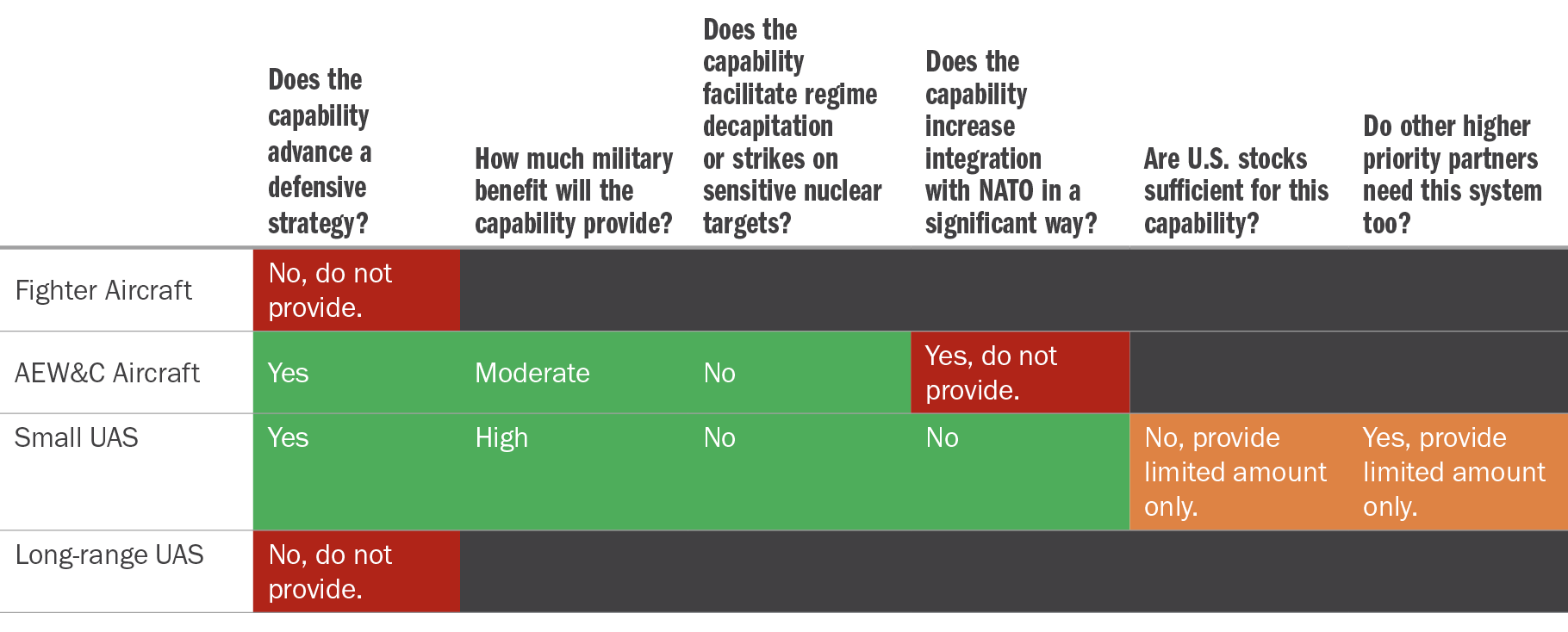
Air-to-air, air-to-ground, and ground-launched missiles and bombs
Ukraine has requested and received large numbers of missiles and bombs of various types, including ground-launched and air-launched weapons from short to longer range. Surface-to-air missiles used primarily for air defense are discussed in the next section.
The longest-range weapon Ukraine has received from the United States is the ATACMS, a ground-launched missile with a range of about 190 miles. Currently Ukraine has been permitted only to strike targets inside Russian-held Ukrainian territory and right along Russia’s border, not deep inside Russia. Other ground-launched missiles and bombs that Ukraine has received include the Guided Multiple Launch Rocket System (GMLRS), which can reach 50 miles (or about 100 miles with the extended range variant), and the ground-launched small diameter bomb that has a range of about 100 miles. Air-to-ground munitions that Ukraine has received include the AGM-88 High-speed Anti-Radiation Missile (HARM) and the Joint Direct Attack Munition (JDAM) and JDAM-ER (extended range) to enable precision strikes. The most recent addition came with the announcement that Ukraine would receive the Joint Standoff Weapon (JSOW) for its F-16 fleet, with a range of about 70 miles. Air-to-air missiles Ukraine has received from the United States include the Air Interceptor Missile (AIM)-9M, AIM-7, AIM-9X, and Advanced Medium-Range Air-to-Air Missile (AMRAAM) (which it has also used as a surface-to-air missile).48“U.S. Security Cooperation with Ukraine,” U.S. Department of State, September 27, 2024, https://www.state.gov/u-s-security-cooperation-with-ukraine/#:~:text=21%20air%20surveillance%20radars. U.S. European allies have also provided a range of missiles with similar capabilities, the most notable being the SCALP and Storm Shadow longer range missiles from France and Britain, respectively.
Even a defensive strategy will require some short-range missiles and bombs, to destroy enemy tanks and artillery located outside but approaching the defensive perimeter. As the range of missiles and bombs gets longer, however, it becomes harder to categorize them as defensive in nature. Advocates of providing Ukraine with longer-range weapons and permissions to use these weapons deep inside Russia argue these missiles can support a defensive campaign by disrupting Russian supply lines to impede their advance or destroying their missile launchers and munitions stockpiles that fuel Russian glide bomb attacks on Ukrainian cities and military targets. However, while these types of strikes might impose pain on Russia’s military, they are unlikely to have large tactical effects or disrupt Russian operations over the long run.49Stephen Biddle, “The False Promise of Ukraine’s Deep Strikes Into Russia.” Longer-range missiles, then, are poor servants of a defensive strategy, being both expensive and inefficient, especially given the small number of longer-range missiles Ukraine has received from the United States and other NATO allies.
At the same time, longer-range missiles could have a moderate-to-high risk of escalation, especially if they can reach sensitive command-and-control targets and come with expanded targeting permissions. Missiles like ATACMS also require extensive U.S. support, including for targeting, and so would increase direct U.S. involvement in longer-range strikes—another driver of escalation.
There is a stronger defensive case for shorter-range missiles used to target advancing Russian forces, tanks or artillery, and forward positioned stockpiles and missile launchers. At this point in the war, there are likely few of these targets in range, and Ukraine would need a sizeable stock to make an operational difference if that changes. Still, these missiles could offer some benefits in holding off a Russian offensive.50Patrick Tucker, “Ukraine’s Western Arms Have Inflicted ‘Significant Damage’ on Russian Supply, Communications Lines, Top US Officer Says,” Defense One, September 8, 2022, https://www.defenseone.com/threats/2022/09/ukraines-western-arms-have-inflicted-significant-damage-russian-supply-communications-lines-top-us-officer-says/376908/. Their overall utility will also be limited by Russia’s effective EW jamming.51“Why Ukraine Wants to Use Western Long-Range Missiles Inside Russia,” AP News, September 13, 2024, https://apnews.com/article/ukraine-russia-missiles-war-nato-zelenskyy-b8039dcdd5b5f03415acd757fbead8e6. As a result, any missiles and bombs sent now would mostly be used as insurance, to ensure that if Russian forces started moving closer to Ukrainian lines, Ukraine’s armed forces could strike back.
Finally, there is the issue of stockpiles. Military experts generally agree that U.S. missile stockpiles are insufficient to meet the needs of a major power war.52Seth Jones, “Empty Bins in a Wartime Environment: The Challenge to the U.S. Defense Industrial Base,” Center for Strategic and International Studies, January 23, 2023, https://www.csis.org/analysis/empty-bins-wartime-environment-challenge-us-defense-industrial-base. This is especially true of longer-range precision missiles that the United States might need in a conflict in Asia. Missiles like the Joint Air-to-Surface Standoff Missile (JASSM) (which Ukraine has not received, but some in the U.S. military have suggested as an option) and the JSOW have been identified as particularly important for an Indo-Pacific contingency.53Mark Cancian, Matthew Cancian, and Eric Heginbotham, “The First Battle of the Next War: Wargaming a Chinese Invasion of Taiwan,” Center for Strategic and International Studies, 2023, https://www.csis.org/analysis/first-battle-next-war-wargaming-chinese-invasion-taiwan; Katie Bo Lillis, Natasha Bertrand, and Kylie Atwood, “US military compiled list of American weapons systems that could help Ukraine in the war with Russia,” CNN, October 8, 2024, https://www.cnn.com/2024/10/08/politics/us-military-weapons-systems-ukraine/index.html. They are also relatively hard to manufacture, meaning stocks are more difficult to replenish. The United States has limited supplies of GMLRS and AMRAAMS as well, both of which would be valuable for Taiwan as part of an asymmetric defense.
Where stockpiles are low, policymakers will need to consider production rates and the competing demands of U.S. forces and allies and partners across regions. For example, missiles like the JSOW and JASSM would play a much greater role in a U.S. war with China than in Ukraine. Currently, U.S. stocks of both missiles are insufficient and production per year is constrained, reaching 750 per year on average for each missile. GMLRS would be useful for both Taiwan’s and Ukraine’s armed forces, but production rates are much higher at 14,000 missiles per year. JDAMs could similarly be useful in both conflicts but this weapon has a surge production of 50,000 per year.54John Tirpak, “Lockheed Gets $3.5 Billion for JASSM/LRASM Missiles as It Eyes ‘Extreme Range’ Variant,” Air and Space Forces Magazine, September 30, 2024, https://www.airandspaceforces.com/lockheed-jassm-lrasm-missiles-contract-extreme-range; “Joint Standoff Weapon (JSOW,” Defense Daily, https://www.defensedaily.com/joint-stand-off-weapon-jsowmanufacturerraytheon-rtn; Mark Cancian, “Is the United States Running out of Weapons to Send to Ukraine?” Center for Strategic and International Studies, September 2022, https://www.csis.org/analysis/united-states-running-out-weapons-send-ukraine; Ryan Brobst and Bradley Bowman, “Can the U.S. Arm Israel, Ukraine, and Taiwan at the Same Time?” Foundation for the Defense of Democracies, October 24, 2023, https://www.fdd.org/analysis/2023/10/24/can-the-u-s-arm-israel-ukraine-and-taiwan-at-the-same-time. Based on this assessment, the United States should restrict transfers of JASSM and JSOW but might allow some GMLRS and JDAM transfers to Ukraine—assuming any transfers to Ukraine were matched with equal or greater transfers to Taiwan. This approach would continue some munitions aid to Ukraine, while still ensuring other priorities are serviced.
Future Ukrainian receipts of most types of U.S.-made missiles and bombs would be quite limited under these recommendations. This is in keeping with a shift to defensive strategy that also recognizes the limits of U.S. stockpiles. What is left should be sufficient to support a defensive stand in Ukraine. Future aid packages should not include any more advanced or longer-range missiles (for example, the new Army PRSM or Tomahawk Land Attack Missile) than Ukraine already has on the basis that such weapons are unnecessary for a defensive strategy, potentially escalatory, and face significant tradeoffs with U.S. need and other partners.
Instead, missiles and bombs sent to Ukraine should be limited to weapons with ranges below 50 miles, which should be sufficient for defensive operations. This would limit ground-launched weapons in future aid packages to GMLRS (fired from HIMARS), assuming the United States and Ukraine can overcome GPS denial issues. It would limit air-launched weapons to the older AIM-9 and AMRAAM variants, but it would exclude the most advanced air-to-air missiles, for example the AIM-9X and AIM-120D. Of air-to-ground systems, the JDAM and JDAM-ER are relatively easy to produce and short-range, but HARM missiles are in shorter supply and so should be kept out of future packages. Finally, it goes without saying that strikes inside Russia would be off-limits in a defensive-oriented approach, and no additional ATACMS would be provided.
Even for missiles provided, quantities should be limited by other U.S. priorities. For those making decisions about allocating aid, it is important that for some capabilities—missiles being one—even a full year’s worth of production would still likely fall short of what Kyiv says it needs, undermining the likely value of any of these systems that are transferred.55J.D. Vance, “The Math on Ukraine Doesn’t Add Up,” New York Times, April 12, 2024, https://www.nytimes.com/2024/04/12/opinion/jd-vance-ukraine.html.
Tables 2 summarizes these recommendations.
Table 2: Ground-launched weapons, air-to-surface weapons, and air-to-air weapons
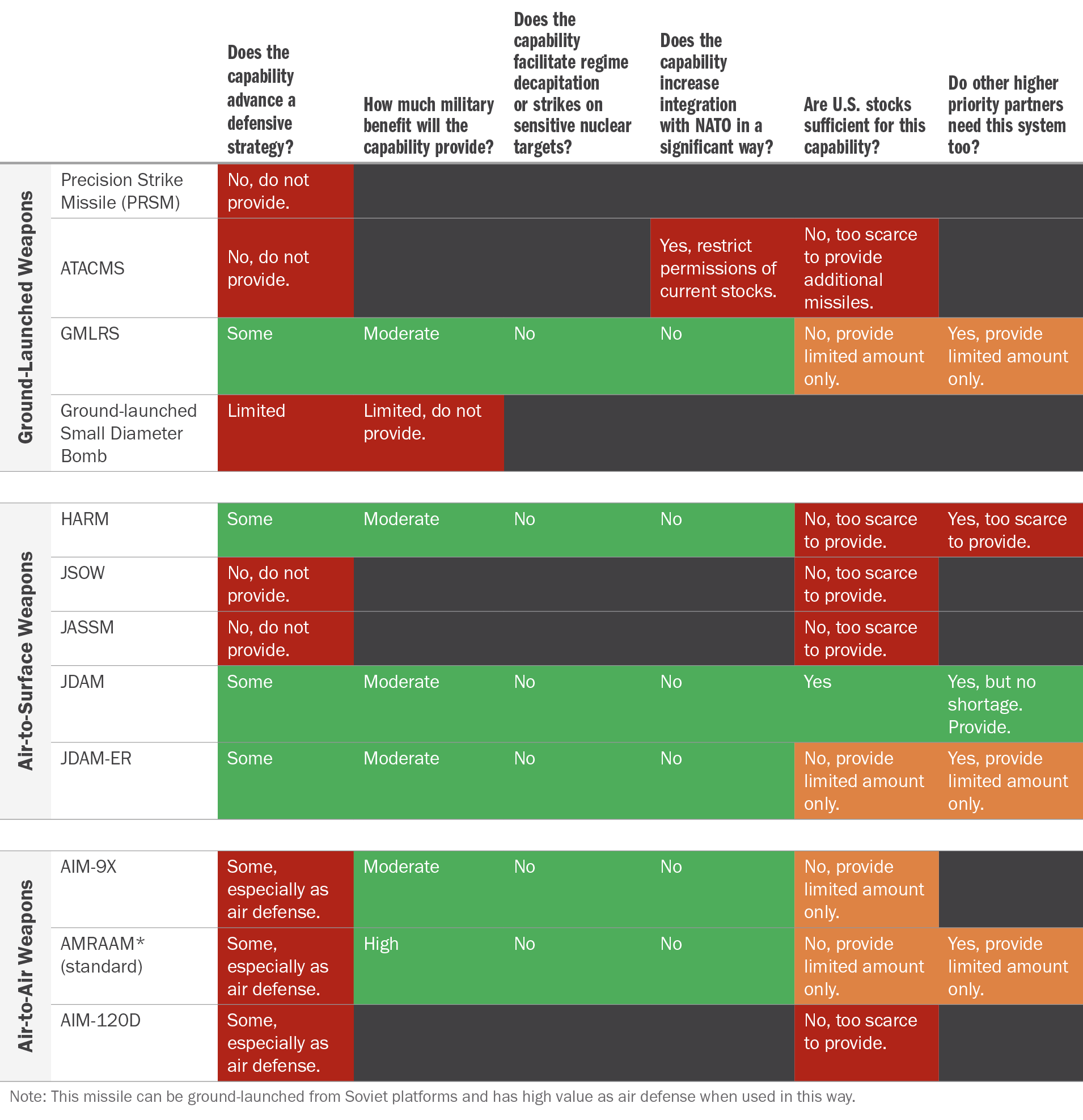
Air defense and surface-to-air missiles
Air defense is one of the most defensively oriented capabilities that the United States could provide to Ukraine. Whether manportable and short-range or mobile and long-range, Ukraine needs air defense of all kinds to defend against Russian bombs, missiles, and drones and to protect its civilian infrastructure, its supply lines, and its front-line forces. Ukraine has received a range of different types of air defense systems and surface-to-air missiles from the United States, including Avenger systems and the Stinger missiles they fire; HAWK air defense systems and missiles; Patriot systems and PAC-2 and PAC-3 missiles; National Advanced Surface-to-Air Missile System (NASAMS) and their missiles; and RIM-7 Sea Sparrow missiles it has fired from old Soviet platforms.56“U.S. Security Cooperation with Ukraine,” U.S. Department of State, October 21, 2024, https://www.state.gov/u-s-security-cooperation-with-ukraine/.
Escalation risks from most types of air defense are quite low as it is recognized to be a defensive capability with little offensive benefit. As with most things, however, there are exceptions. Some of the most advanced air defenses would require a greater integration between Ukraine and the West, including possibly needing Western operators. In addition, their effectiveness could undermine Russia’s confidence in the deterrent capacity of its most advanced weapons. Together, these factors could drive escalation. The Aegis Ashore capability, a land-based version of the Aegis ballistic missile defense system, would likely be escalatory if placed inside Ukraine, for instance. First, it would suggest deeper integration between Ukraine and NATO countries, where most other Aegis ashore systems are located. Second, because the Aegis system could take down an Intercontinental Ballistic Missile, it might threaten Putin’s confidence in his nuclear deterrent. Putting a Terminal High Altitude Area Defense (THAAD) system in Ukraine—apart from issues associated with the complexity of the system and its scarcity—would likely be destabilizing for the same reasons.
While most other air defense systems should be considered for future military aid to Ukraine, the value and utility of these systems mean that they are in high demand, not only in Ukraine but by U.S. forces and allies and partners in Asia and Europe. The secretary of the Army, for instance, acknowledged that the United States did not have sufficient Patriot systems to resource potential future needs in Asia, and studies have suggested that partners in Asia and Europe have only a fraction of the air defense they would need in a conflict.57Wormuth, “Ground Forces and Great Powers.” Henry Foy and John Paul Rathbone, “Nato has just 5% of air defences needed to protect eastern flank,” Financial Times, May 29, 2024, https://www.ft.com/content/5953405f-d91a-4598-8b6b-6345452ca328; Mackenzie Eaglen, “The U.S. Navy Doesn’t Have Enough Air Defense Missiles,” National Interest, January 4, 2024, https://www.aei.org/op-eds/the-u-s-navy-doesnt-have-enough-air-defense-missiles/. NASAMS and HAWK air defense are limited in supply and would be very useful as part of an asymmetric strategy in Europe. Stinger missiles have a long backlog, due to bottlenecks for input parts and technology obsolescence issues.58Howard Altman and Tyler Rogoway, “U.S. Diverting Missiles from Foreign Customers to Ukraine Could Have Repercussions Beyond Air Defense,” Warzone, June 20, 2024, https://www.twz.com/air/u-s-diverting-missiles-from-foreign-customers-to-ukraine-could-have-repercussions-beyond-air-defense. Sea Sparrow missiles are similarly under strain due to their use in the Middle East, and their likely utility in any Asian contingency. In other words, although Ukraine needs air defense, supplies are short, and demand is high elsewhere as well. This should place strict limits on what can be included in future aid packages.
The Biden administration’s current approach has been to prioritize Ukraine for many types of air defense. They have limited the transfer of Patriot missiles to countries other than Ukraine and plan to send Ukraine another Patriot system as part of the September 2024 transfer of aid—despite the Army’s own publicly recognized shortage.59C. Todd Lopez, “Latest Security Assistance for Ukraine Announced, White House Directs DOD to Allocate Remaining Appropriations,” DOD News, https://www.defense.gov/News/News-Stories/Article/Article/3918679/latest-security-assistance-for-ukraine-announced-white-house-directs-dod-to-all/. These moves are ill-advised. The United States should supply Ukraine with air defense and air defense missiles, but it should not do so at the expense of U.S. needs or the needs of other allies and partners.
Future deliveries will, therefore, need to be more limited. The degree of restrictions will depend on the system. THAAD systems and missiles should be off the table due to limited supply (the United States has only seven of these) as well as the escalation risk noted above. Future aid packages might include some Patriot missiles, but available supplies should be split evenly between Ukraine, U.S. forces, and key Asian partners like Taiwan and allies like Japan. Additional Patriot systems should not be included.
Similarly, decisions about shorter range systems, including NASAMS, HAWK, and Avenger anti-aircraft systems (and Stinger missiles), should reflect their high demand and limited supply. When they are available, new production should be split across U.S. forces, top Asian allies and partners, and Ukraine. In no case should Ukraine’s needs be met at the exclusion of the requirements of East Asian allies and partners, however. Aid to Ukraine has already set the readiness of these countries back and preventing further backsliding should be a priority, especially since almost no quantity of these missiles would be enough to fully address Kyiv’s needs.
In addition to air defense systems and missiles, Ukraine has received from the United States several types of counter (c)-UAS that can be used against adversary drones and loitering munitions which have wreaked havoc on Ukrainian military forces and civilian targets—often by overwhelming more traditional air defenses. Here, stockpile sufficiency could be an issue. The U.S. military does not have enough c-UAS, especially smaller ones, to meet the likely demands of a war in Asia, even for its own forces.60Brandi Vincent, “Lawmakers Push DOD to Designate New ‘Executive Agent’ for Counter-Small Drone Oversight,” Defense Scoop, May 13, 2024, https://defensescoop.com/2024/05/13/lawmakers-push-dod-to-designate-new-executive-agent-for-counter-small-drone-oversight/. These systems would also be of high importance for Taiwan, given that any Chinese invasion or even blockade of the island is likely to involve large numbers of drones. As a result of these competing demands, any additional transfers should be limited in quantity.
Finally, Ukraine has received air surveillance and other ground radars and sensors which can be used to detect incoming missiles, planes, drones, and mortars. For the most part, these can be considered defensive capabilities, though this assumes that these radars and ground-based sensors would remain minimally connected with Western networks. Some integration would be required, as radars would likely rely on U.S. and NATO satellites, but this should remain limited. Too much integration could be escalatory.
For example, Ukraine has asked for (and the U.S. Army is eager to provide) more extensive integration into NATO data and sensing networks, including access to Link 16, a military tactical data network that connects NATO and other U.S. partners so that they share a common operating picture and threat assessment.61Lillis, Bertrand, and Atwood, “US military compiled list of American weapons systems.” Ukraine wants to be included in this network for many reasons, and improved air defense targeting is one of them. This system could have defensive value for Ukraine, and it is not subject to supply constraints, but it would suggest deep integration of U.S. and Ukrainian capabilities and information sharing that would deepen the U.S. role in the war and raise new escalatory risks.
Table 3 summarizes this assessment of air defense capabilities that might go to Ukraine.
Table 3: Air defense capabilities
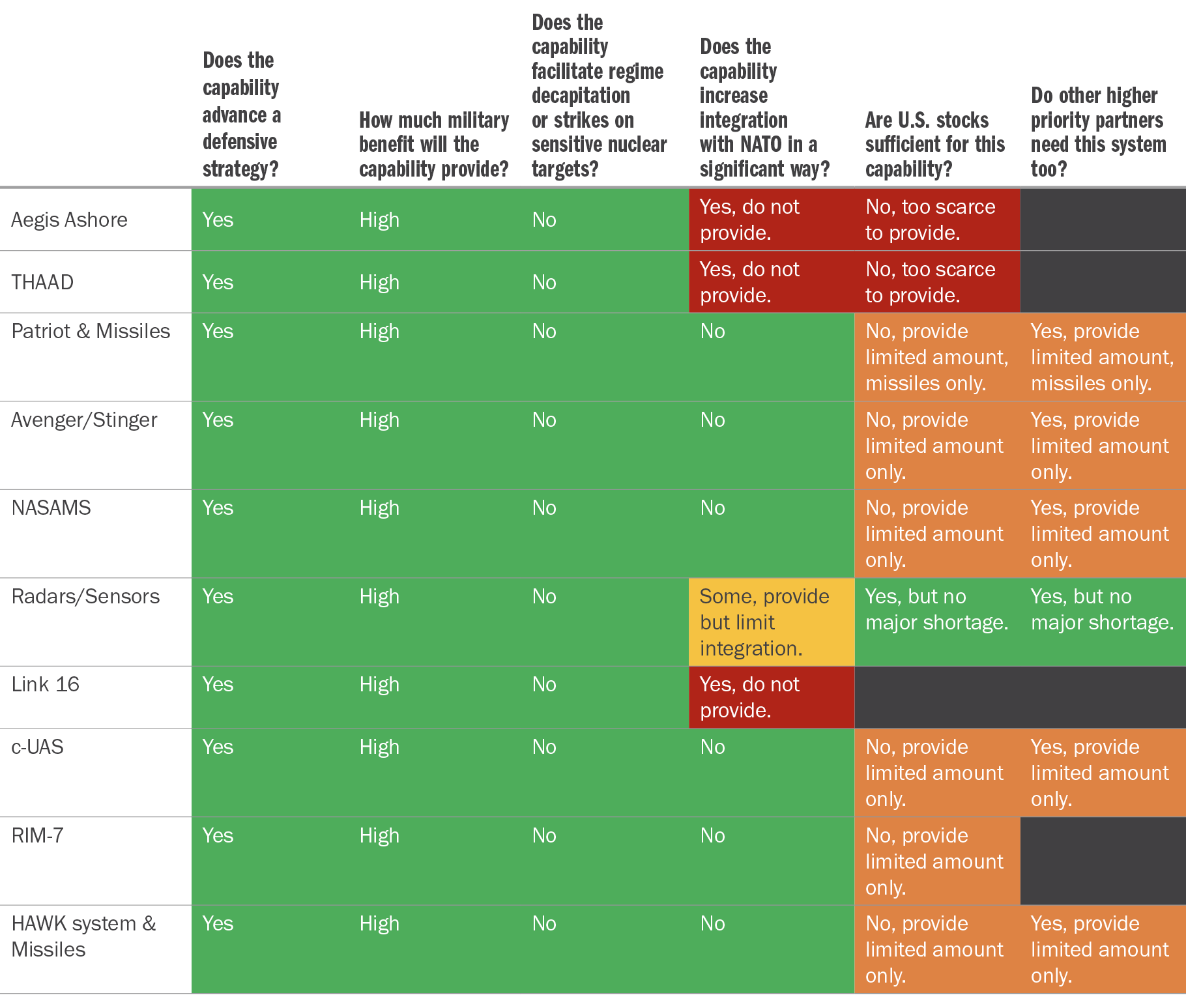
Artillery and anti-tank munitions
The main artillery platforms the United States has sent to Ukraine include the Howitzer and HIMARS. Howitzers, which come in several variants, can fire exclusively short-range munitions, such as the 155mm and 105mm rounds (and 155mm Excalibur precision rounds) that Ukraine has received in the hundreds of thousands. HIMARS can fire shorter- and longer-range missiles, including GMLRS, ATACMS, and the new Army Precision Strike Missile (PRSM). The most effective anti-tank systems the U.S. has sent include the manportable Javelin and the vehicle-mounted, Tube-launched, Optically Tracked, Wire-guided (TOW) missile along with a range of other anti-tank and anti-armor munitions.
These systems can be used offensively or defensively, but in the Ukraine context it is hard to imagine a defensive stand that does not rely on artillery and anti-tank munitions as one part of a set of layered defensive lines able to halt and turn back further Russian advances.62Thomas Mutch, “In a World of Drones, Ukraine’s Artillerymen Rushed to Defend Kharkiv,” Defense News, August 22, 2024, https://www.defensenews.com/global/europe/2024/08/22/in-a-world-of-drones-ukraines-artillerymen-rushed-to-defend-kharkiv/. The military effectiveness of artillery as part of defensive strategy will generally be at least moderate, assuming sufficient munitions. To engineer an effective defensive stand, Ukraine will need to be able to blanket an oncoming adversary with fires, protecting its positions. Generally, the United States has not been able to keep up with Ukraine’s demand for ammunition for its artillery platforms or, to a lesser extent, its need for artillery platforms themselves.
The escalation risk of HIMARS, Howitzer, and other artillery systems depends on the munitions provided. When armed with the shorter range 155mm and 105mm ammunition (or other variants) or even the GMLRS, most artillery platforms will have a low escalation risk. Escalation risk rises with longer-range missiles because they can reach farther inside Russia or behind the front lines and suggest greater integration between the Ukraine and the West when it comes to intelligence and targeting. Anti-tank missiles are primarily defensive and should have low escalation risk, intended to disable advancing adversary armored vehicles, including tanks and others.
The bigger constraint on artillery and anti-tank/anti-armor systems and munitions will be availability. Though the United States has relatively robust stocks of older Howitzers and other artillery systems that it may be able to transfer, its supplies of ammunition are quite limited. U.S. efforts to ramp up its production of ammunition at all calibers, including especially 155mm and 155mm Excalibur rounds, have received significant attention, culminating in high-profile visits of U.S. Army leaders to production facilities in Scranton, Pennsylvania. Progress has been made but major shortages still exist, leaving Ukraine at a disadvantage against Russian forces.63Marc Levy, “Unprepared for Long War, US Army Under Gun to Make More Ammo,” AP News, April 23, 2023, https://apnews.com/article/us-army-ukraine-russia-ammunition-war-75a9ca2e3be09578c65f1198ba5b72e5.
Not only is the demand in Ukraine exceeding new U.S. supplies, but U.S. stocks have been drawn down and will need to be replenished. Since October 2023, Ukraine has also had to share available supplies with Israel, and U.S. partners in Asia like Taiwan are looking to stockpile ammunition to prepare for a possible conflict with China. Notably, these supply constraints on production and demand-side competition are likely to affect all types of ammunition, including 105mm, 122mm, and others. To the extent future aid packages include ammunition, decisionmakers should ensure that other U.S. priorities (U.S. forces, U.S. Asian allies and partners) receive some portion of any new production.
Compared to Howitzers, HIMARS production is considerably more constrained, though Lockheed Martin has been ramping up production. There are many European and Asian allies looking to buy or waiting for additional HIMARS, but the most at-risk partner is Taiwan, which could use the system to harden defenses at its landing beaches.64Max Stewart, “Island Blitz: A Campaign Analysis of a Taiwan Takeover by the Pla,” CIMSEC, June 13, 2023, https://cimsec.org/island-blitz-a-campaign-analysis-of-a-taiwan-takeover-by-the-pla/. That and the needs of the U.S. military itself will limit the ability of the United States to provide more of this system to Ukraine in the near term. The missiles fired from HIMARS are even more constrained, as described above. As a result, aid in these areas will be restricted going forward.
When it comes to anti-tank systems, the story is a bit brighter. Though the same competition between Taiwan and Ukraine exists for both new production and current stocks, supplies of TOW missiles are less constrained. Though only about 1,000 are produced each year, there are efforts to increase this, and U.S. stockpiles are quite large.65Cancian, “Is the United States Running out of Weapons to Send to Ukraine?” The TOW missile should, therefore, make up a large portion of future U.S. aid to Ukraine. Javelin stocks are lower. The United States likely cannot transfer more of these through PDA in the near term, but Lockheed Martin has had success in ramping up its Javelin production which should ease constraints, though transfers will still be limited in the near term.66Lockheed Martin, “Ramping Up: Lockheed Martin Steadily Increasing Production of High-Demand Systems,” February 15, 2024, https://www.lockheedmartin.com/en-us/news/features/2024/ramping-up–lockheed-martin-steadily-increasing-production-o.html.
Table 4 summarizes these recommendations.
Table 4: Artillery and anti-tank munitions
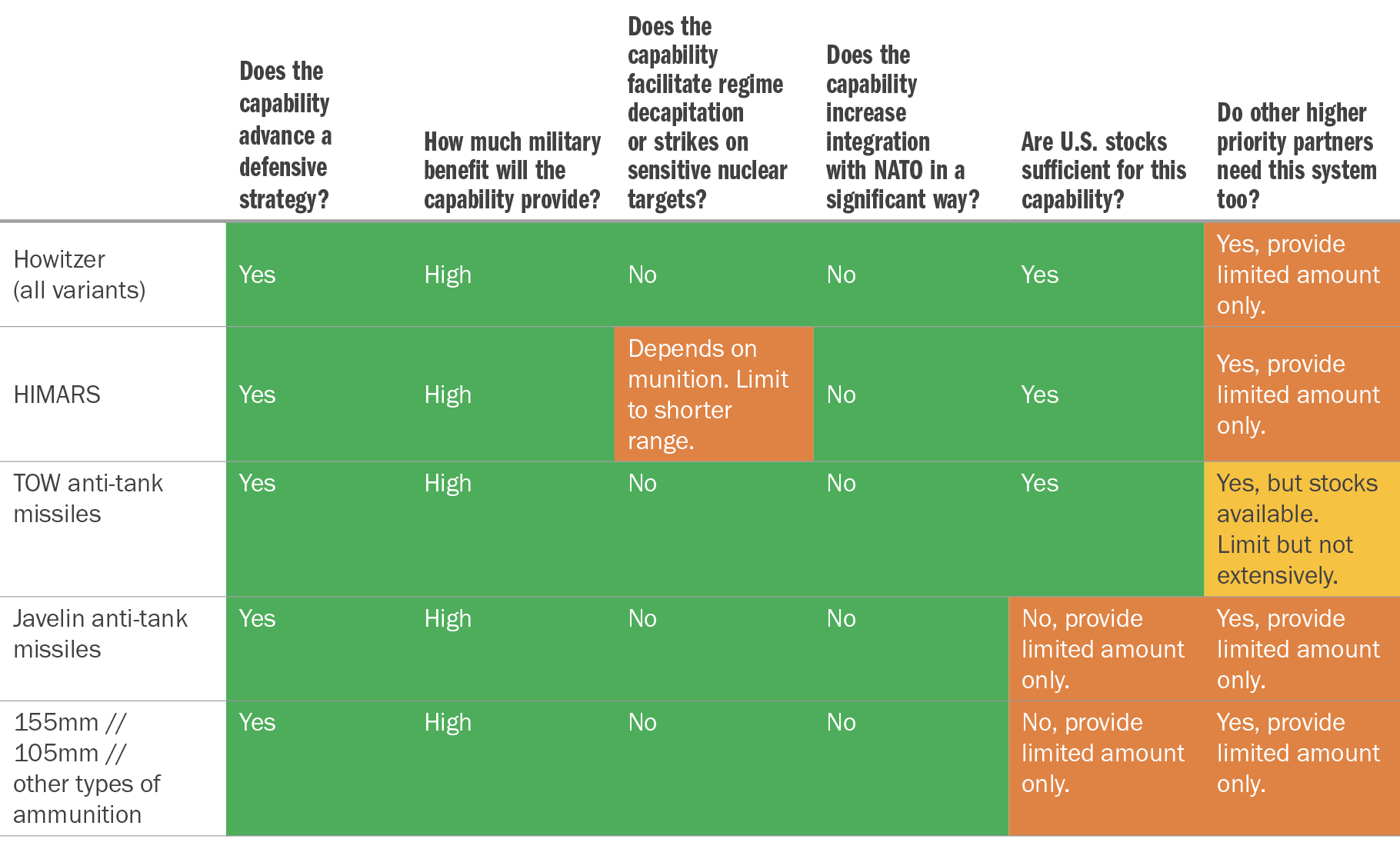
Tanks and ground vehicles
In Ukraine, ground vehicles have provided fewer offensive benefits than anticipated. The United States provided tanks (Abrams and others), Bradley Fighting Vehicles, and Strykers to aid Ukraine’s 2023 counteroffensive, but these proved to be quite vulnerable to mines and easily targeted by Russian drones and munitions.67Tara Copp, “Ukraine pulls US-provided Abrams tanks from the front lines over Russian drone threats,” Associated Press, April 26, 2024, https://apnews.com/article/ukraine-russia-war-abrams-tanks-19d71475d427875653a2130063a8fb7a. Most of the tanks have been moved away from the front lines at this point, and the Bradleys that remain (Ukraine has lost up to a third of the 300 the United States provided) are being used in non-traditional but largely offensive ways, such as hunting and fighting Russian armored vehicles.68Alex Horton and Serhii Korolchuk, “‘Ram Him’: How Ukraine is Pushing U.S. Combat Gear to the Extreme,” Washington Post, June 12, 2024, https://www.washingtonpost.com/national-security/2024/06/12/ukraine-bradley-fighting-vehicles-combat-video/. Strykers have been more offensively valuable, able to move more nimbly through Russian missiles and across contested territory. They played a substantial role in the Kursk offensive, for example, which allowed Ukraine to seize territory inside Russia.69“Ukrainian US-Donated Stryker Armored Vehicles Show High Combat Effectiveness in Kursk Operation,” Army Recognition, August 16, 2024, https://armyrecognition.com/focus-analysis-conflicts/army/conflicts-in-the-world/russia-ukraine-war-2022/ukrainian-us-donated-stryker-armored-vehicles-show-high-combat-effectiveness-in-kursk-operation. None of these systems have particularly high escalation risks, as even the Stryker has relatively limited offensive potential on a battlefield covered in drones and mines. U.S. stockpiles are also seemingly not a major constraint and allied competition for these systems is only modest and not that urgent. Even for Taiwan, which is waiting for an order of Abrams tanks, heavy ground vehicles are low priority military needs due to survivability concerns. European demand is more substantial though not that time urgent, and many in Europe have turned to South Korean K2 tanks instead.70Jaroslaw Adamowski, “Eyes on Ukraine, Demand for Tanks Is Bubbling Up in Eastern Europe,” Defense News¸ June 14, 2024, https://www.defensenews.com/global/europe/2024/06/14/eyes-on-ukraine-demand-for-tanks-is-bubbling-up-in-eastern-europe/.
However, despite low escalation risks and fewer supply constraints, as systems that favor the offensive and have little defensive purpose in Ukraine, all three types of vehicles should be kept out of future aid packages.
Ukraine will, however, need some kind of ground vehicle to allow it to move along its defensive perimeter to reinforce its lines and resupply forces. For this, smaller armored vehicles like the M117 armored security vehicle, the M113 armored personnel carrier, the High Mobility Multipurpose Wheeled Vehicle (HMMWV), or even the Mine Resistant Ambush Protected Vehicle (MRAP), of which the United States has a large supply, are well-suited. These pose little escalation risk and fit well in a defensive strategy. Operating behind Ukrainian lines, they should be relatively well-protected and so Ukraine’s needs for these should be modest. They may have enough already but if they need more, there is no risk in providing some.71Carla Babb, “Pentagon Needs $10B to Replace Weapons Already Sent to Ukraine, Officials Say,” VOA, March 11, 2024, https://www.voanews.com/a/pentagon-needs-10b-to-replace-weapons-already-sent-to-ukraine-officials-say/7523377.html.
Finally, the United States has already transferred large numbers of support vehicles to Ukraine, for instance, fuel tankers, medical transport, command post vehicles, and recovery vehicles used to repair damaged vehicles. Like personnel transport, these are a necessary part of Ukraine’s defensive operations. The United States should continue to provide these though Ukraine’s demand should be limited. They have already received many and, operating behind defensive lines, they should be reasonably well-protected against Russian attacks.
Table 5 summarizes recommendations for ground vehicles.
Table 5: Tanks and ground vehicles
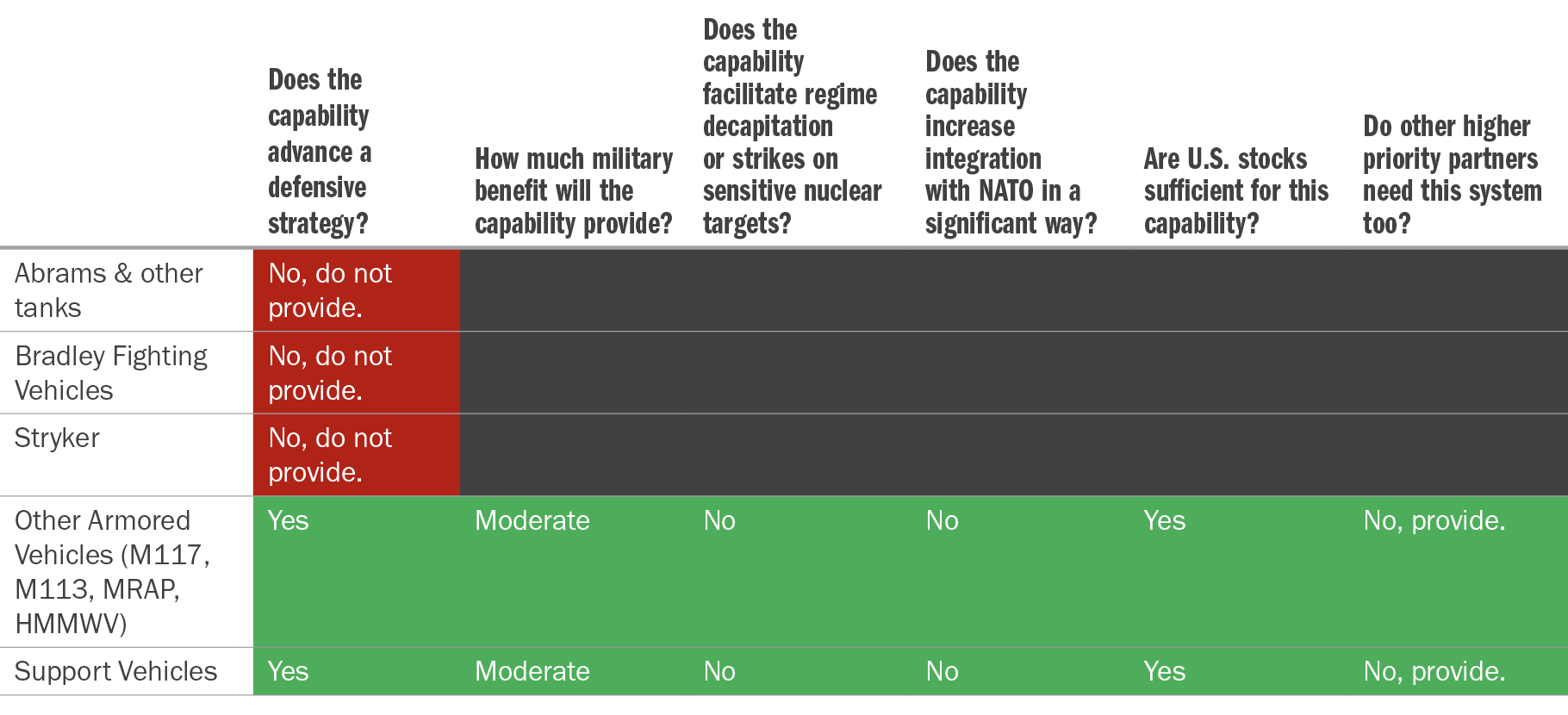
Mines, fortifications, and combat engineering
Mines and fortifications will be an essential part of a defensive strategy over the short and long terms for Ukraine. Layers of anti-tank mines and construction of fortifications such as concrete trenches, reinforced barriers and bunkers, “dragon’s teeth” anti-tank fortifications, and other obstacles layered with artillery fire and short-range munitions can help Ukraine set up and hold a strong defensive perimeter that would be costly for Russia to puncture.72Ashford and Grieco, “How Ukraine Can Win through Defense.” The United States should be willing to provide Ukraine with the capabilities it needs to build these defenses. In fact, this should be the near-term focal point of U.S. aid efforts. Most of these supplies and materials are cheap, and even those in short supply can be quickly replaced to support U.S. needs and those of other partners. Ukraine will need concrete, along with combat engineering equipment capable of digging trenches and constructing barricades, bunkers, and trenches.
For the most part, this equipment doesn’t pose any kind of escalation risk and the costs and tradeoffs will be low. The United States should preserve its own capabilities in combat engineering and support the needs of other allies and partners, but there should not be major shortages. However, as with everything, there are some exceptions. Some types of combat engineering equipment will be more useful than others to a defensive strategy. Since resources are constrained, the United States should try to strictly focus aid it provides on those systems most necessary to defensive operations. This might recommend against providing capabilities such as mobile bridges (included in the September 2024 aid package to Ukraine) and minesweepers because these largely aid Ukraine’s mobility rather than its ability to construct defenses.73Craig Hooper, “Armored Bridges To Ukraine: Last Pieces for a Counter-Attack Coming into Place,” Forbes, March 3, 2023, https://www.forbes.com/sites/craighooper/2023/03/03/armored-bridges-to-ukraine-last-pieces-for-a-counter-attack-coming-into-place/.
Table 6 offers a summary.
Table 6: Mines, fortifications, and combat engineering
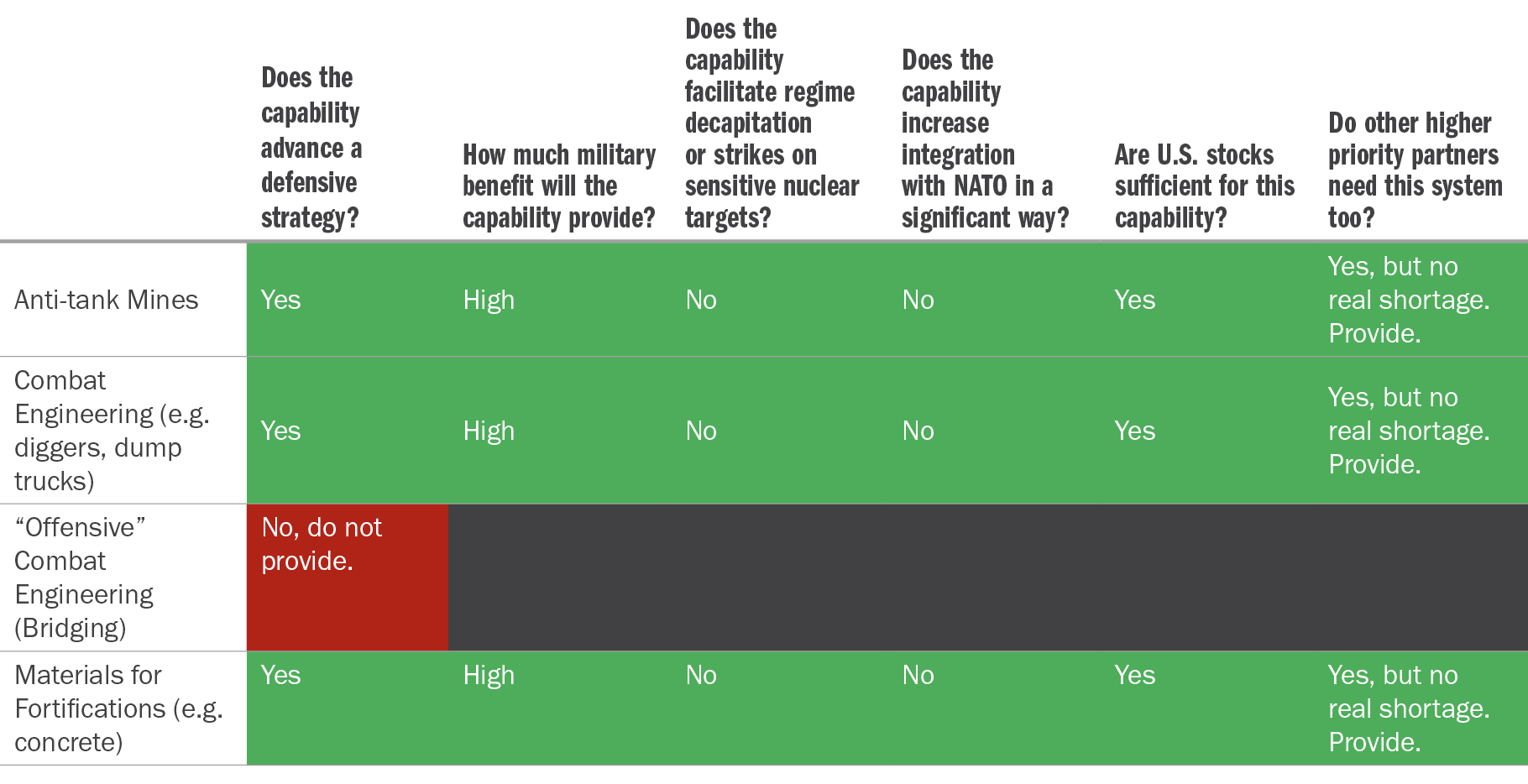
Maritime capabilities
The United States has not provided Ukraine with significant quantities of maritime weapons and systems, which makes sense since it does not have a navy. However, Ukraine has been able to use anti-ship missiles and sea drones to take out some Russian ships in the Black Sea, forcing Russia’s navy to move away from the Ukrainian coast.74John Grady, “Battles in the Black Sea Changing the Character of Naval Warfare, Experts Say,” USNI News, June 13, 2024, https://news.usni.org/2024/06/13/battles-in-the-black-sea-changing-the-character-of-naval-warfare-experts-say. As part of a defensive campaign, Ukraine will need a way to continue defending its coastline, but this is a less urgent need than ground capabilities, so it should fall further down any U.S. priorities list. The United States has already given Ukraine two Coastal Defense Systems and Harpoon anti-ship missiles and should be willing to provide additional anti-ship missiles as well as attritable sea drones. Both have a high degree of military effectiveness, but neither is likely to be all that escalatory. Harpoon anti-ship missiles have a range of about 90 miles, and attritable sea drones can damage ships but pose little offensive threat to Russia.
The bigger concern in both cases will be stockpiles, which are limited. Any system that can be used in a maritime context likely is needed in Asia. The United States should therefore limit additional Harpoon missile transfers and exclude any further Coastal Defense System transfers. Ideally, less advanced, older, or shorter-range anti-ship missiles might be substituted into aid packages to Ukraine, but at the very least Taiwan should receive at least two times as many anti-ship munitions as are sent to Ukraine (e.g., two missiles to Taiwan for each to Ukraine). When it comes to sea drones, Ukraine has some of its own production capacity. The United States should encourage this indigenous development but may need to limit U.S. provision of this technology due to the competing and more urgent demands of U.S. forces and Asian allies and partners.
Table 7 summarizes these observations.
Table 7: Maritime capabilities
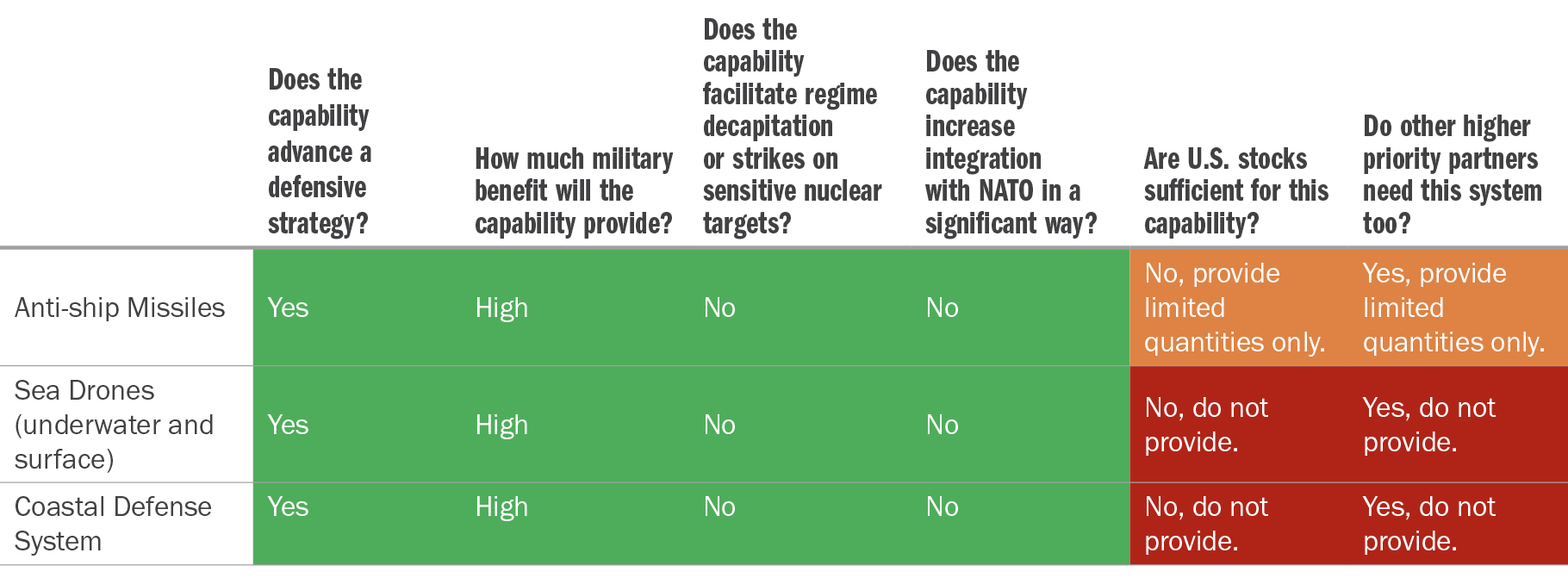
Trainers and contractors inside Ukraine
A final type of aid would be to send U.S. military trainers and contractors into Ukraine to assist in the training of recruits and the maintenance of equipment. There are two stated rationales for this, but neither holds up. First, some argue that U.S. contractors and military personnel are better at these tasks than Ukrainian soldiers because they have more experience.75Grady, “Battles in the Black Sea.” This may be true for maintenance activities or longer-term training for advanced military skills, but it is unlikely to be the case for training activities focused on today’s war. Although the U.S. military has been leading training of Ukrainian forces in Germany and elsewhere, Ukrainian personnel have complained that the received training is of limited utility on Ukraine’s front lines.76Alexandra Chinchilla and Sam Rosenberg, “Why Americans Should Send Military Advisers to Ukraine,” Foreign Affairs, September 22, 2023, https://www.foreignaffairs.com/united-states/why-america-should-send-military-advisers-ukraine. When it comes to fighting today’s war, Ukrainian soldiers will likely be better off being traded by hardened Ukrainian veterans.
The second proposed rationale is that U.S. personnel performing these support tasks might reduce some of the manpower challenges Ukraine faces.77Brian Petit, “Send in the A-Team: A Graduated Response for Ukraine,” War on the Rocks, March 7, 2024, https://warontherocks.com/2024/03/send-in-the-a-team-a-graduated-response-for-ukraine/. This is unlikely, since the number of trainers and contractors would likely be quite small and Ukraine’s manpower gap is quite deep. As a result, while sending U.S. trainers and contractors into Ukraine might fit with a defensive strategy, its military value would be quite low.
On the other hand, the escalation risk of such a move would be quite high.78Aila Silsco, “Western Military Trainers in Ukraine Would Be ‘Legitimate Targets’: Russia,” Newsweek, June 4, 2024, https://www.newsweek.com/western-military-trainers-ukraine-target-russia-1908242. First, it would clearly be interpreted by Putin as an increase in direct U.S. involvement (or NATO involvement if the trainers were multinational). Second, U.S. forces and contractors in Ukraine would almost certainly be seen as legitimate targets for Russian missiles and bombs. Even if not intentional, U.S. personnel could easily get caught up in Russian attacks aimed at other targets, raising the risk of escalation. This would force the United States to make hard decisions about how to respond to the deaths of U.S. servicemembers or contractors. There is no good argument, then, for having U.S. personnel on the ground in the Ukraine while fighting continues.
Table 8 summarizes these insights.
Table 8: Trainers and contractors

Summary
Using the framework provided here to guide any additional military assistance to Ukraine would dramatically reshape future aid packages, but not terminate assistance. Instead, future aid packages would include defensive capabilities like air defense, anti-tank and artillery systems and some munitions, some shorter-range missiles (including anti-ship, for the most part less than 50 miles), funding for Ukrainian-produced small UAS, ground-based radars and sensors, anti-tank mines, materials and combat engineering systems to build fortifications and barriers, and armored vehicles for resupply and transport. Combat support, including spare parts, body armor, radios, night vision goggles, medical supplies, and similar equipment, should also be included (at reasonable quantities, preserving U.S. reserves) as necessary enablers that would allow Ukraine to effectively operate along a new defensive perimeter against Russian incursions.
Even within this list, some quantities would be restricted by competing U.S. and partner demands (especially Taiwan), including all types of air defense, some artillery munitions, most types of missiles, and some types of mines. In some cases, restrictions and limits on what can be sent to Ukraine will be significant. In others, supply issues will mean short-term holds on certain classes of materiel that other partners or U.S. forces need more than Ukraine does. Decisionmakers will need to consider not just the immediate crisis in Ukraine but also the long-term needs in the United States and in Asia. In some cases, Taiwan’s or Japan’s needs may come before Ukraine’s, or at least deserve equal attention and access to U.S. materiel. Where these gaps weaken Ukraine’s defenses, European partners should be expected to fill the gap.
Future aid packages will be constrained in both quantities and types of equipment, even as the United States tries to shore up Ukraine’s defense. The framework here may allow policymakers to identify where tradeoffs are greatest and to justify their decisions. It will also be useful for adjudicating the value and risks of other capabilities not explicitly discussed here that are proposed or requested by Ukraine.
Constraints on U.S. aid are a natural outcome of a U.S. defense posture which is overstretched and a Ukraine strategy that has been based on hope rather than reality for almost three years. A defensive strategy in Ukraine that focuses on holding current territory only is both more realistic and more sustainable for the United States than an offensive one or than the ad hoc and ill-defined approach the Biden administration adopted. Many of the systems included in defensive aid packages are cheaper and easier to produce than exquisite offensive systems that the United States has been providing and that Kyiv has been asking for.
Still the United States will need help to make this work. Europe should be encouraged to align its aid with the United States and Ukraine should be pressed to concentrate its investment in defensive technologies only. The next administration will still need to make needed investments in its own defense industrial base, including especially for munitions, air defense, uncrewed sea and air drones—not only to meet needs in Ukraine or in Asia but to fulfill the demands of its own military. The Departments of State and Defense will also need to streamline the FMS process especially for high priority clients.
Critics will find a defense-only approach unsatisfying or a breach of U.S. commitments to support Ukraine “as long as it takes.” But unlimited and indefinite aid to Ukraine is not sustainable nor is it in U.S. interests. Even if it were possible, it would not give Ukraine a chance at victory. At this point, even with focused investments in its defense, Ukraine may struggle to maintain its current territory. This is why it is urgent that any strategic change is made now.
Table 9 offers a final summary to guide future aid packages.
Table 9: Summary guide
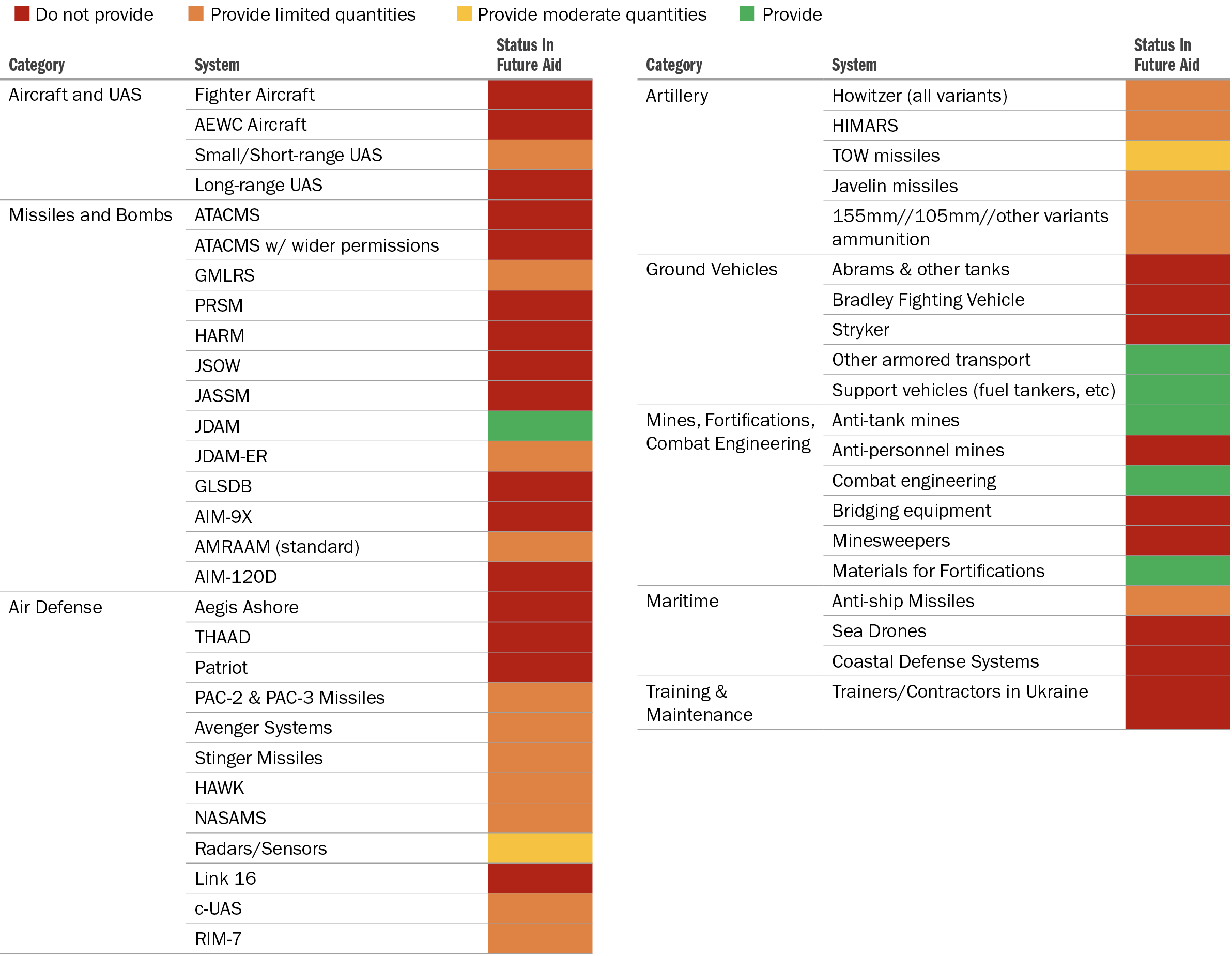
Endnotes
- 1Alexander Vindman, “What the U.S. Election Means for Ukraine,” Foreign Affairs, September 25, 2024, https://www.foreignaffairs.com/ukraine/what-us-election-means-ukraine.
- 2George Beebe, “Not enough long range missiles to make a difference for Ukraine,” Responsible Statecraft, September 13, 2024, https://responsiblestatecraft.org/ukraine-long-range-missiles/; Stephen Biddle, “The False Promise of Ukraine’s Deep Strikes Into Russia,” Foreign Affairs, August 28, 2024, https://www.foreignaffairs.com/ukraine/false-promise-ukraines-deep-strikes-russia.
- 3Michael DiMino, “No Silver Bullet: Aid is Not a Shortcut to Victory for Ukraine,” Defense Priorities, June 21, 2024, https://www.defensepriorities.org/explainers/no-silver-bullet/; Emma Ashford, Joshua Shifrinson, and Stephen Wertheim, “What Does America Want in Ukraine?” Foreign Policy, May 9, 2024, https://foreignpolicy.com/2024/05/09/america-ukraine-forever-war-congress-aid/.
- 4Joshua Shifrinson, “American Interests in the Ukraine War,” Defense Priorities, September 2023, https://www.defensepriorities.org/reports/american-interests-in-the-ukraine-war/.
- 5“Equipment Losses in Russia’s War on Ukraine Mount,” International Institute for Strategic Studies (IISS), February 12, 2024, https://www.iiss.org/online-analysis/military-balance/2024/02/equipment-losses-in-russias-war-on-ukraine-mount/.
- 6Bryan Frederick, Mark Cozad, and Alexandra Stark, “Understanding the Risk of Escalation in the War in Ukraine,” RAND Corporation, 2023, https://www.rand.org/content/dam/rand/pubs/research_briefs/RBA2800/RBA2807-1/RAND_RBA2807-1.pdf; Emma Ashford and Kelly Grieco, “How Ukraine Can Win Through Defense,” Foreign Affairs, January 10, 2024, https://www.foreignaffairs.com/ukraine/how-ukraine-can-win-through-defense.
- 7Carl von Clausewitz, On War (London: Kegan Paul, Trench, Trubner & Co., 1918); Stephen Biddle, Military Power: Explaining Victory and Defeat in Modern Battle (Princeton: Princeton University Press, 2004).
- 8John J. Mearsheimer, “Assessing the Conventional Balance: The 3:1 Rule and Its Critics,” International Security 13, no. 4 (1989): 54–89.
- 9Christopher Miller, “Volodymyr Zelenskyy faces backlash over Russia’s breach of eastern defences,” Financial Times, August 30, 2024, https://www.ft.com/content/e63ce931-d3a1-4b4a-8540-e578d87873e5.
- 10Keir A. Lieber, “Grasping the Technological Peace: The Offense-Defense Balance and International Security,” International Security 25, no. 1 (2000): 71–104; Lieber, “Mission Impossible: Measuring the Offense-Defense Balance with Military Net Assessment,” Security Studies 20 (2001): 451–459.
- 11Jack S. Levy, “The Offensive/Defensive Balance of Military Technology: A Theoretical and Historical Analysis,” International Studies Quarterly 28, no. 2 (1984): 219–238.
- 12Levy, “Offensive/Defensive Balance.”
- 13David Blagden, “When Does Competition Become Conflict? Technology, Geography, and the Offense-Defense Balance,” Journal of Global Security Studies 6, no. 4 (2021) https://academic.oup.com/jogss/article/6/4/ogab007/6238548.
- 14Blagden, “When Does Competition Become Conflict?”
- 15David Brennan, “America’s Abrams Tanks Are Failing the Ukraine Test,” Newsweek, April 26, 2024, https://www.newsweek.com/american-abrams-tanks-failing-ukraine-test-russia-drones-1894503.
- 16Ashford and Grieco, “How Ukraine Can Win.”
- 17Karen DeYoung and John Hudson, “U.S. Will Send Ukraine Long-Range Missiles, after Delay,” Washington Post, September 22, 2023, https://www.washingtonpost.com/national-security/2023/09/22/atacms-ukraine-cluster-munitions/.
- 18Jeff Abramson, “Ukraine Landmine Use Under Scrutiny,” Arms Control Association, March 2023, https://www.armscontrol.org/act/2023-03/news/ukraine-landmine-use-under-scrutiny.
- 19Courtney Kube, “Pentagon Has Recommended Giving White Phosphorus Shells to Ukraine, but White House Keeps Saying No,” NBC News, September 25, 2024, https://www.nbcnews.com/investigations/pentagon-wants-white-phosphorus-shells-ukraine-white-house-says-no-rcna172504.
- 20Constant Meheut, “Zelensky Says Push Into Russia Shows the West’s Red Lines Are ‘Naïve,’” New York Times, August 20, 2024, https://www.nytimes.com/2024/08/20/world/europe/ukraine-russia-war-incursion-zelensky.html; Alexander Vindman, “Stop Tiptoeing Around Russia,” Foreign Affairs, August 8, 2022, https://www.foreignaffairs.com/united-states/stop-tiptoeing-around-russia.
- 21“US scrambled to urge Putin not to use nuclear weapons in Ukraine, Woodward book says,” Associated Press, October 8, 2024, https://apnews.com/article/russia-ukraine-war-putin-biden-nuclear-weapons-90cb3bb3499a5e211095b3f93173a575.
- 22Benoit Faucon and Thomas Grove, “Russia Provided Targeting Data for Houthi Assault on Global Shipping,” Wall Street Journal, October 24, 2024, https://www.wsj.com/world/russia-provided-targeting-data-for-houthi-assault-on-global-shipping-eabc2c2b.
- 23Levy, “Offensive/Defensive Balance”; Blagden, “When Does Competition Become Conflict?”
- 24James M. Acton, “Escalation through Entanglement: How the Vulnerability of Command-and-Control Systems Raises the Risks of an Inadvertent Nuclear War,” International Security 43, no. 1 (2018): 56–99; Tong Zhao, “Conventional Long-Range Strike Weapons of US Allies and China’s Concerns of Strategic Instability,” Nonproliferation Review 27 (2020): 109–122.
- 25“China says AUKUS on ‘dangerous path’ with nuclear subs deal,” Associated Press, March 14, 2023, https://apnews.com/article/china-aukus-nuclear-submarines-f6ecf854646e2dbddd6ebeaa2f2e971d.
- 26Frederick, Cozad, and Stark, “Understanding the Risk of Escalation.”
- 27Stephen Watts et al., Deterrence and Escalation in Competition with Russia: The Role of Ground Forces in Preventing Hostile Measures below Armed Conflict in Europe (RAND Corporation, 2022), https://www.rand.org/pubs/research_reports/RRA720-1.html.
- 28Frederick, Cozad, and Stark, “Understanding the Risk of Escalation.”
- 29“Report to Congress on Defense Production for Ukraine,” Congressional Research Service Report, September 16, 2024, https://s3.documentcloud.org/documents/25163101/defense-production-for-ukraine-background-and-issues-for-congress-sept-16-2024.pdf.
- 30Congressional Research Service, “Defense Production for Ukraine.”
- 31Christine Wormuth, “Ground Forces and Great Powers,” Stimson Center, September 19, 2024, https://www.stimson.org/2024/transcript-ground-forces-and-great-powers-a-conversation-with-u-s-army-secretary-christine-wormuth/.
- 32Jennifer Kavanagh and Jordan Cohen, “The Real Reasons for Taiwan’s Arms Backlog – and How to Help Fill It,” War on the Rocks, January 13, 2023, https://warontherocks.com/2023/01/the-real-reasons-for-taiwans-arms-backlog-and-how-to-help-fill-it/.
- 33Brian Everstine, “U.S. Prioritizing Patriot, NASAMS Interceptors for Ukraine,” Aviation Week, June 20, 2024, https://aviationweek.com/defense/missile-defense-weapons/us-prioritizing-patriot-nasams-interceptors-ukraine.
- 34Kavanagh and Cohen, “The Real Reasons for Taiwan’s Arms Backlog.”
- 35Kavanagh and Cohen, “The Real Reasons for Taiwan’s Arms Backlog.”
- 36“Funding,” Ukraine Oversight, Special Inspector General for Operation Atlantic Resolve, Promoting Whole of Government Oversight of the U.S. Ukraine Response, https://www.ukraineoversight.gov/Funding.
- 37Mark Cancian and Chris Park, “What Is in the Ukraine Aid Package, and What Does it Mean for the Future of the War?” Center for Strategic and International Studies, May 1, 2024, https://www.csis.org/analysis/what-ukraine-aid-package-and-what-does-it-mean-future-war.
- 38Sebastien Roblin, “Sending F-16s to Ukraine Is the Right Choice, But It Will Be a Tough Fight,” Newsweek, May 24, 2023, https://www.newsweek.com/sending-f-16s-ukraine-right-choice-it-will-tough-fight-opinion-1802461.
- 39Reuben Johnson, “Ukraine’s Lost F-16: Debris and a Deadly Mission,” Breaking Defense, September 20, 2024, https://breakingdefense.com/2024/09/debris-and-a-deadly-mission-the-vital-context-around-ukraines-lost-f-16/.
- 40“Ukraine Now Has F-16s; Here’s What to Know about the Possible Impact,” VOA, August 4, 2024, https://www.voanews.com/a/ukraine-now-has-f-16s-here-s-what-to-know-about-the-possible-impact/7727046.html.
- 41Parth Satam, “Ukraine to Get Sweden’s AWACS in First Airborne Radar Donation,” Aviationist, May 29, 2024, https://theaviationist.com/2024/05/29/ukraine-to-get-swedish-awacs/; “AWACS: NATO’s ‘Eyes in the Sky,’” NATO, November 14, 2023, https://www.nato.int/cps/en/natohq/topics_48904.htm.
- 42Stacie L. Pettyjohn, “Drones Are Transforming the Battlefield in Ukraine but in an Evolutionary Fashion,” War on the Rocks, March 5, 2024, https://warontherocks.com/2024/03/drones-are-transforming-the-battlefield-in-ukraine-but-in-an-evolutionary-fashion/.
- 43Jennifer Kavanagh, “Arming for the Air Littoral: The Defense Industrial Base and Future Air Warfare,” Aether: A Journal of Strategic Airpower & Spacepower 3, no. 3 (2024) https://www.airuniversity.af.edu/Portals/10/AEtherJournal/Journals/Volume-3_Number-3/Kavanagh.pdf.
- 44John Grady, “‘Hellscape’ Swarms Could Be a Cost-Effective Taiwan Defense, Says Report,” USNI News, July 2, 2024, https://news.usni.org/2024/07/01/hellscape-swarms-could-be-as-cost-effective-taiwan-defense-says-report.
- 45Carter Johnston, “Breaking Down the U.S. Nacy’s ‘Hellscape’ in Detail,” Naval News, June 16, 2024, https://www.navalnews.com/naval-news/2024/06/breaking-down-the-u-s-navys-hellscape-in-detail/.
- 46Isobel Koshiw, “Ukraine weighs lifting arms export ban to scale up drone industry,” Financial Times, October 9, 2024, https://www.ft.com/content/aec4c3b3-56ab-4774-b342-250d5445ba6e.
- 47Yaroslav Trofimov, “Ukraine Is Striking Deeper Inside Russia—and Reshaping the War,” Wall Street Journal, October 26, 2024, https://www.wsj.com/world/europe/ukraine-is-striking-deeper-inside-russiaand-reshaping-the-war-23e0174d.
- 48“U.S. Security Cooperation with Ukraine,” U.S. Department of State, September 27, 2024, https://www.state.gov/u-s-security-cooperation-with-ukraine/#:~:text=21%20air%20surveillance%20radars.
- 49Stephen Biddle, “The False Promise of Ukraine’s Deep Strikes Into Russia.”
- 50Patrick Tucker, “Ukraine’s Western Arms Have Inflicted ‘Significant Damage’ on Russian Supply, Communications Lines, Top US Officer Says,” Defense One, September 8, 2022, https://www.defenseone.com/threats/2022/09/ukraines-western-arms-have-inflicted-significant-damage-russian-supply-communications-lines-top-us-officer-says/376908/.
- 51“Why Ukraine Wants to Use Western Long-Range Missiles Inside Russia,” AP News, September 13, 2024, https://apnews.com/article/ukraine-russia-missiles-war-nato-zelenskyy-b8039dcdd5b5f03415acd757fbead8e6.
- 52Seth Jones, “Empty Bins in a Wartime Environment: The Challenge to the U.S. Defense Industrial Base,” Center for Strategic and International Studies, January 23, 2023, https://www.csis.org/analysis/empty-bins-wartime-environment-challenge-us-defense-industrial-base.
- 53Mark Cancian, Matthew Cancian, and Eric Heginbotham, “The First Battle of the Next War: Wargaming a Chinese Invasion of Taiwan,” Center for Strategic and International Studies, 2023, https://www.csis.org/analysis/first-battle-next-war-wargaming-chinese-invasion-taiwan; Katie Bo Lillis, Natasha Bertrand, and Kylie Atwood, “US military compiled list of American weapons systems that could help Ukraine in the war with Russia,” CNN, October 8, 2024, https://www.cnn.com/2024/10/08/politics/us-military-weapons-systems-ukraine/index.html.
- 54John Tirpak, “Lockheed Gets $3.5 Billion for JASSM/LRASM Missiles as It Eyes ‘Extreme Range’ Variant,” Air and Space Forces Magazine, September 30, 2024, https://www.airandspaceforces.com/lockheed-jassm-lrasm-missiles-contract-extreme-range; “Joint Standoff Weapon (JSOW,” Defense Daily, https://www.defensedaily.com/joint-stand-off-weapon-jsowmanufacturerraytheon-rtn; Mark Cancian, “Is the United States Running out of Weapons to Send to Ukraine?” Center for Strategic and International Studies, September 2022, https://www.csis.org/analysis/united-states-running-out-weapons-send-ukraine; Ryan Brobst and Bradley Bowman, “Can the U.S. Arm Israel, Ukraine, and Taiwan at the Same Time?” Foundation for the Defense of Democracies, October 24, 2023, https://www.fdd.org/analysis/2023/10/24/can-the-u-s-arm-israel-ukraine-and-taiwan-at-the-same-time.
- 55J.D. Vance, “The Math on Ukraine Doesn’t Add Up,” New York Times, April 12, 2024, https://www.nytimes.com/2024/04/12/opinion/jd-vance-ukraine.html.
- 56“U.S. Security Cooperation with Ukraine,” U.S. Department of State, October 21, 2024, https://www.state.gov/u-s-security-cooperation-with-ukraine/.
- 57Wormuth, “Ground Forces and Great Powers.” Henry Foy and John Paul Rathbone, “Nato has just 5% of air defences needed to protect eastern flank,” Financial Times, May 29, 2024, https://www.ft.com/content/5953405f-d91a-4598-8b6b-6345452ca328; Mackenzie Eaglen, “The U.S. Navy Doesn’t Have Enough Air Defense Missiles,” National Interest, January 4, 2024, https://www.aei.org/op-eds/the-u-s-navy-doesnt-have-enough-air-defense-missiles/.
- 58Howard Altman and Tyler Rogoway, “U.S. Diverting Missiles from Foreign Customers to Ukraine Could Have Repercussions Beyond Air Defense,” Warzone, June 20, 2024, https://www.twz.com/air/u-s-diverting-missiles-from-foreign-customers-to-ukraine-could-have-repercussions-beyond-air-defense.
- 59C. Todd Lopez, “Latest Security Assistance for Ukraine Announced, White House Directs DOD to Allocate Remaining Appropriations,” DOD News, https://www.defense.gov/News/News-Stories/Article/Article/3918679/latest-security-assistance-for-ukraine-announced-white-house-directs-dod-to-all/.
- 60Brandi Vincent, “Lawmakers Push DOD to Designate New ‘Executive Agent’ for Counter-Small Drone Oversight,” Defense Scoop, May 13, 2024, https://defensescoop.com/2024/05/13/lawmakers-push-dod-to-designate-new-executive-agent-for-counter-small-drone-oversight/.
- 61Lillis, Bertrand, and Atwood, “US military compiled list of American weapons systems.”
- 62Thomas Mutch, “In a World of Drones, Ukraine’s Artillerymen Rushed to Defend Kharkiv,” Defense News, August 22, 2024, https://www.defensenews.com/global/europe/2024/08/22/in-a-world-of-drones-ukraines-artillerymen-rushed-to-defend-kharkiv/.
- 63Marc Levy, “Unprepared for Long War, US Army Under Gun to Make More Ammo,” AP News, April 23, 2023, https://apnews.com/article/us-army-ukraine-russia-ammunition-war-75a9ca2e3be09578c65f1198ba5b72e5.
- 64Max Stewart, “Island Blitz: A Campaign Analysis of a Taiwan Takeover by the Pla,” CIMSEC, June 13, 2023, https://cimsec.org/island-blitz-a-campaign-analysis-of-a-taiwan-takeover-by-the-pla/.
- 65Cancian, “Is the United States Running out of Weapons to Send to Ukraine?”
- 66Lockheed Martin, “Ramping Up: Lockheed Martin Steadily Increasing Production of High-Demand Systems,” February 15, 2024, https://www.lockheedmartin.com/en-us/news/features/2024/ramping-up–lockheed-martin-steadily-increasing-production-o.html.
- 67Tara Copp, “Ukraine pulls US-provided Abrams tanks from the front lines over Russian drone threats,” Associated Press, April 26, 2024, https://apnews.com/article/ukraine-russia-war-abrams-tanks-19d71475d427875653a2130063a8fb7a.
- 68Alex Horton and Serhii Korolchuk, “‘Ram Him’: How Ukraine is Pushing U.S. Combat Gear to the Extreme,” Washington Post, June 12, 2024, https://www.washingtonpost.com/national-security/2024/06/12/ukraine-bradley-fighting-vehicles-combat-video/.
- 69“Ukrainian US-Donated Stryker Armored Vehicles Show High Combat Effectiveness in Kursk Operation,” Army Recognition, August 16, 2024, https://armyrecognition.com/focus-analysis-conflicts/army/conflicts-in-the-world/russia-ukraine-war-2022/ukrainian-us-donated-stryker-armored-vehicles-show-high-combat-effectiveness-in-kursk-operation.
- 70Jaroslaw Adamowski, “Eyes on Ukraine, Demand for Tanks Is Bubbling Up in Eastern Europe,” Defense News¸ June 14, 2024, https://www.defensenews.com/global/europe/2024/06/14/eyes-on-ukraine-demand-for-tanks-is-bubbling-up-in-eastern-europe/.
- 71Carla Babb, “Pentagon Needs $10B to Replace Weapons Already Sent to Ukraine, Officials Say,” VOA, March 11, 2024, https://www.voanews.com/a/pentagon-needs-10b-to-replace-weapons-already-sent-to-ukraine-officials-say/7523377.html.
- 72Ashford and Grieco, “How Ukraine Can Win through Defense.”
- 73Craig Hooper, “Armored Bridges To Ukraine: Last Pieces for a Counter-Attack Coming into Place,” Forbes, March 3, 2023, https://www.forbes.com/sites/craighooper/2023/03/03/armored-bridges-to-ukraine-last-pieces-for-a-counter-attack-coming-into-place/.
- 74John Grady, “Battles in the Black Sea Changing the Character of Naval Warfare, Experts Say,” USNI News, June 13, 2024, https://news.usni.org/2024/06/13/battles-in-the-black-sea-changing-the-character-of-naval-warfare-experts-say.
- 75Grady, “Battles in the Black Sea.”
- 76Alexandra Chinchilla and Sam Rosenberg, “Why Americans Should Send Military Advisers to Ukraine,” Foreign Affairs, September 22, 2023, https://www.foreignaffairs.com/united-states/why-america-should-send-military-advisers-ukraine.
- 77Brian Petit, “Send in the A-Team: A Graduated Response for Ukraine,” War on the Rocks, March 7, 2024, https://warontherocks.com/2024/03/send-in-the-a-team-a-graduated-response-for-ukraine/.
- 78Aila Silsco, “Western Military Trainers in Ukraine Would Be ‘Legitimate Targets’: Russia,” Newsweek, June 4, 2024, https://www.newsweek.com/western-military-trainers-ukraine-target-russia-1908242.
More on Europe
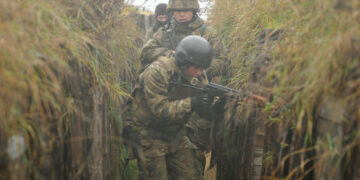
Featuring Jennifer Kavanagh
October 24, 2025

Featuring Jennifer Kavanagh
October 23, 2025

Featuring Jennifer Kavanagh
October 18, 2025
Events on Ukraine-Russia
